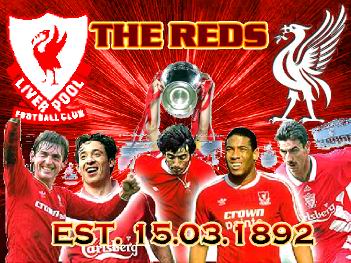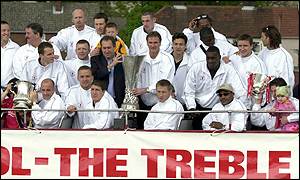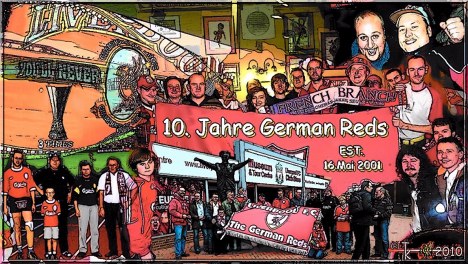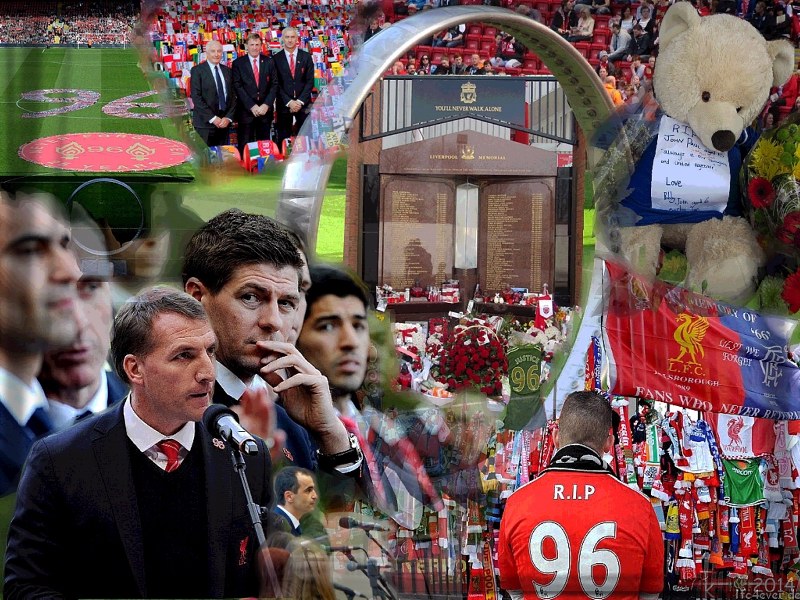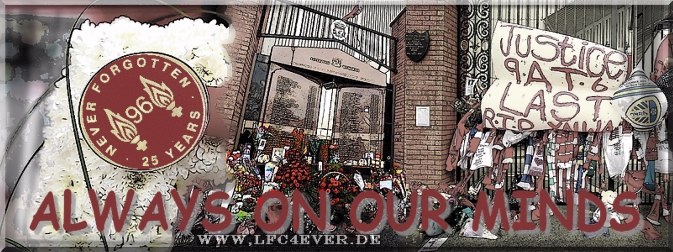| (English) |
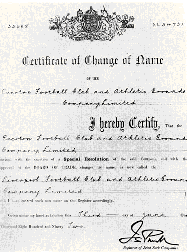 |
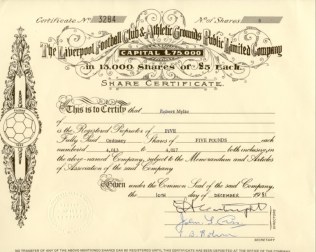 |
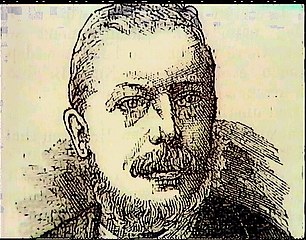 |
Die Entstehung des Vereins hängt eng mit der Entwicklung der Industrie zusammen, da die methodistische Kirche sich zum Ziel gemacht hatte, in den Arbeiterwohngebieten der industriellen Ballungsgebiete aktiv zu werden, um die dort lebenden Menschen vor allen schlechten Einflüssen wie Alkohol & Prügeleien zu bewahren!
1878 wurde auf Initiative des Reverend Chambers im Liverpooler-Stadtteil Everton der St.Domingo`s FC gegründet, der im folgenden Jahr in den Everton FC umbenannt wurde.
Da Everton in Liverpool schnell zum besten Club wurde, und bei Zuschauerzahlen von 2000-3000 Fans ein neuer Spielort gesucht wurde, sprang in der Notsituation der Brauereibesitzer John Houlding ein, der an der Anfield Road ein Gelände besaß, das er für 100 englische Pfund an Everton verpachtete.
Am 27.09.1884 trug Everton hier sein erstes Spiel aus!
Im Laufe der 80`er Jahre des letzten Jahrhunderts wurde Fußball noch populärer, so das sich die1863 gegründete Football Association entschloss, eine landesweite Liga einzurichten!
Am 08.09.1888 wirkte der Everton FC vor 10000 Zuschauern am Beginn des modernen Fußball mit.
1891 konnte der Verein seine erste Meisterschaft feiern!
In Anbetracht der Erfolge und der Zuschauerzahlen erhöhte Mr. Houlding im Frühjahr 1892 die Pacht auf 250 englisch Pfund, wodurch es zur großen Krise kam!
Da die Mitglieder des Everton FC die erhöhte Pacht nicht Zahlen wollten, kauften sie das Gelände ca.500 Meter entfernt an der Goodison Road, wo Everton nun seine Heimspiele austrug!
Da stand er dann da in der rauen, zugigen Luft am Mersey-River, John Houlding, ein reicher Mann mit einem eigenen Stadion, aber ohne Fußball Club!
W.E.Barclay. ein Freund und Business-Ratgeber, wusste einen einfachen, doch genialen Ausweg.
"John, gründe dir deinen eigenen Club" sagte er!
Das war die Geburtsstunde des erfolgreichsten englischen Fußballvereins, des weltberühmten
Liverpool Football Club & Athletics Grounds PLC!
Als Clubfarbe wählten Houlding & Co ein tiefes Rot, schon um sich vom Start weg abzuheben von den "Blauen", vom Rivalen Everton FC, doch die Trikots in der ersten Saison waren noch blau/ weiße vom Vorgänger, da man noch keine eigenen neue für den Spielbetrieb hatte!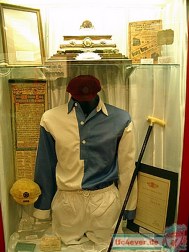
Erstes Shirt 1892
|
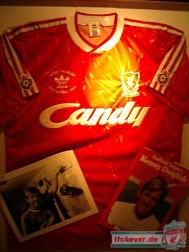
King Kenny, FA-Cup 1986
|
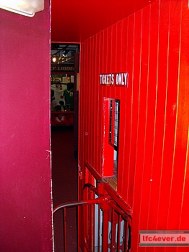
Einlaßtor
|
Diese gewann man gleich im ersten Anlauf und war schon nach drei Jahren in die 1.Division aufgestiegen.
Das war aber etwas zu schnell, so das man gleich wieder Abstieg!
In der 2.Division wurde man wieder Meister, so das man 1896 wieder erstklassig war.
1898/99 wurde man dann immerhin zum ersten mal englischer Vizemeister!
In der Saison 1900-01 wurde man dann zum ersten mal englischer Meister, zwei Punkte vor Sunderland!
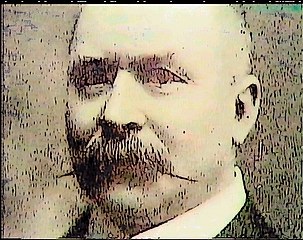
John McKenna
erster Manager des Liverpool FC
|
In der Saison 1903/04 stieg man erneut in die zweite Division ab, doch man wurde gleich im darauffolgenden Jahr Zweitliga Meister & im ersten Jahr darauf in der Saison 1905/06 als Aufsteiger zum zweiten mal englischer Meister! Seit 1906 heißt die Stehplatztribüne am Südwestende des Stadions nach einem Bergkegel in der südafrikanischen Provinz Natal "Spion Kop". Auf diesen Berg starben im zweiten Burenkrieg über 300 Soldaten aus dem Lancashire Regiment, in dem viele aus Liverpool und Umgebung stammten. Mit 28.000 Zuschauer im Kop hatte Liverpool die damals größte Stehplatztribüne der Welt. In der Saison 1909/10 wurde man noch mal Vizemeister, danach dümpelte man außer im Jahr 1914 als man das englisch FA-Cup Finale gegen Burnley erreichte, das mit 0:1 verloren wurde, bis zum ersten Weltkrieg im Mittelfeld der Liga herum. Nach dem Krieg wurde man 1921/22 & 22/23 englischer Meister, um dann bis zum zweiten Weltkrieg wieder ins Mittelfeld abzurutschen. |
Überraschend wurde man dann 1946/47 erster Nachkriegsmeister in England!

1954 stieg man dann wieder in die zweite Division ab, wo man bis 1962 blieb!
1959 kam dann der legendäre Trainer Bill Shankly an die Anfield Road, um aus diesem Team eine der besten Mannschaften Europas zu Formen!
Unter Shankly ging es wieder vorwärts mit den Reds und man wurde 1962 wieder Zweitliga Meister!
In der Saison 1963/64 wurde Liverpool dann unter Shankly erstmals nach 16.Jahren englischer Meister!
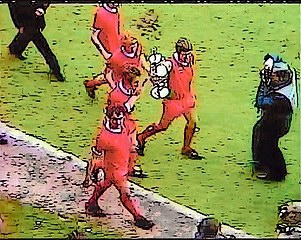 |
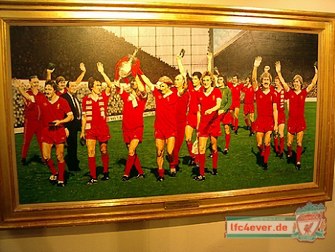 |
"Shanks" baute den Club zu seiner internationalen Größe aus, und nichts tat er lieber, als während seiner Amtszeit von 1959-74 die Reporter aus der ganzen Welt durch die "Kathedrale Anfield" zu führen!
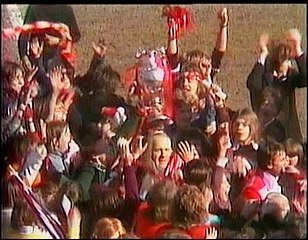 |
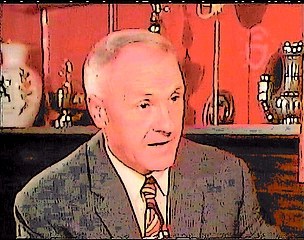 |
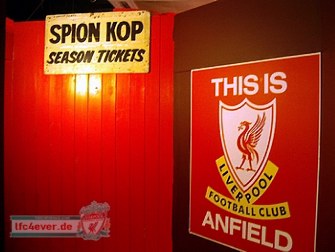 |
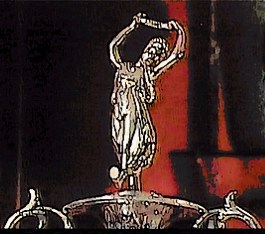 |
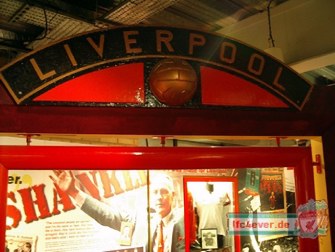 |
Gleich in seiner ersten Saison als Manager holte er den Charity-Shield (1975) wurde 1976 englischer Meister und holte den UEFA-Cup!
Doch es sollte noch besser werden, 1977 wurde man englischer Meister, gewann den Charity-Shield und den Landesmeister-Cup gegen Borussia Mönchengladbach, sowie den Europäischen Supercup mit 6:0 und 1:1 gegen den Hamburger SV!
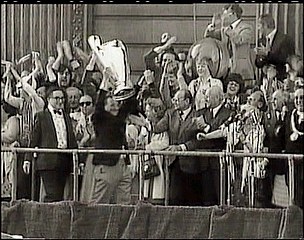 |
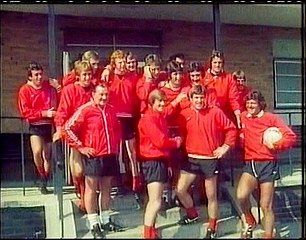 |
1978 holte man erneut den Landesmeister-Cup und den Charity-Shield.
Bis zum Ende der Ära Paisley (1974-83) holte man noch vier mal die Meisterschaft, dreimal den League-Cup, dreimal den Charity-Shield und einmal 1981 den Landesmeister-Cup gegen Real Madrid!
Sein Nachfolger wurde Joe Fagan der gleich in seiner ersten Saison 1983-84 die Meisterschaft, den League-Cup gegen den Erzrivalen Everton, sowie den Landesmeister-Cup gegen den AS Rom im Römer Olympiastadion holte!
Doch in der Saison 1984/85 kam es leider zu den Ausschreitungen im Finale des Landesmeister-Cups in Brüsseler Heyselstadion, wobei 39 Fans von Juventus Turin den Tod fanden.
Danach wurden alle englischen Mannschaften bis 1991 für internationale Wettbewerbe gesperrt!
Fagan trat zurück, und sein Nachfolger war kein geringerer als Kenny Dalglish!
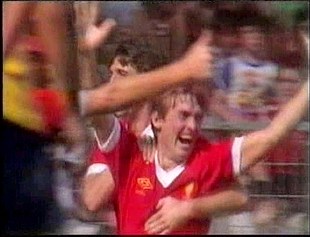 |
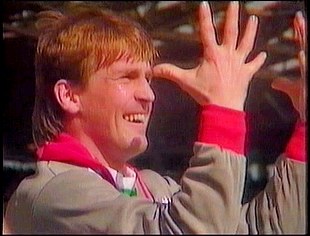 |
Am 15.04.1989 kam es im Halbfinale des FA-Cup`s gegen Nottingham Forest vor dem Spiel zum Hillsborough Unglück, wobei 96 Liverpool-Fans ums leben kamen!
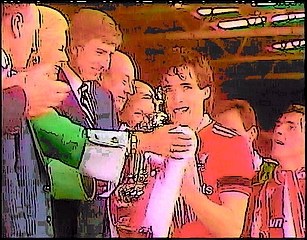 |
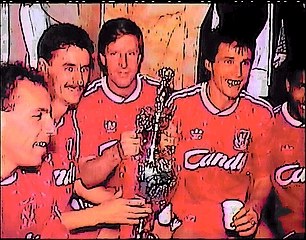 |
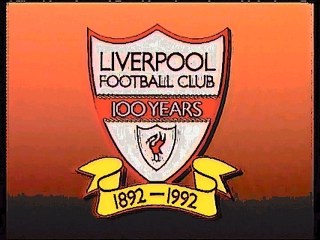
Souness holte 1992 passend zur 100.Jahrfeier den FA-Cup im 111.Finale gegen den Sunderland AFC mit 2:0!
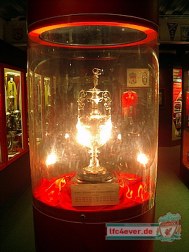 |
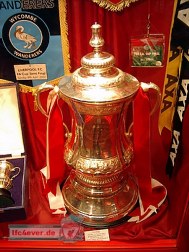 |
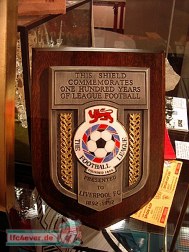 |
 |
 |
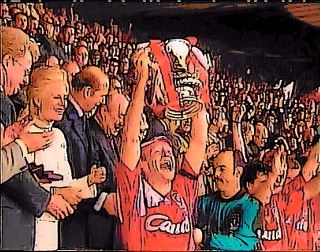 |
Doch bis auf den League-Cup 1995 gegen die Bolton Wanderer gelang nichts mehr!
Seit 1994 ist "The Kop" eine Sitzplatztribüne mit einem Fassungsvermögen von 12.390 Zuschauern. Als "Kopites" bezeichnen sich die Fans dieser Tribüne!
Nach dem man kurz mit zwei Trainern(Evans & Houllier) Experimentierte gab 1998 Roy Evans auf, so das seit dem Gerard Houllier als verantwortlicher Manager fungiert!
Seit 1995 warteten die Fans in aller Welt auf neue Titel, aber 2001 ..........
LIVERPOOL holt das Pokal-Tripel, League-Cup, FA-Cup & UEFA_Cup
so wie den Charity-Shield + europäischen Super-Cup
YOULL'NEVER WALK ALONE!!!
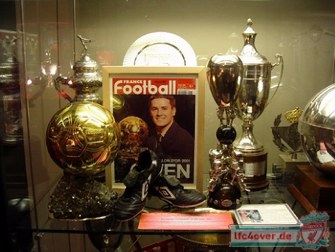 |
Hier erreichte man das Viertelfinale und scheiterte unglücklich am späteren Finalisten Bayer 04 Leverkusen!
In der Meisterschaft wurde man zweiter hinter Arsenal & Verbesserde sich wieder um einen Platz gegenüber dem Vorjahr!
Robbie Fowler wurde an Leeds United verkauft, Gary McAllister ging zu Coventry City & Jamie Redknapp zu Tottenham Hotspurs!
2002-03 läuft es in der Meisterschaft nicht so Rund, allerdings konnte man gegen Manchester United den League-Cup zum 7.x gewinnen!
In der Champions-League kam man nicht über die erste Gruppenfasse & scheiterte an CF Valencia & dem FC Basel!
Man rettet sich aber durch den dritten Platz in den UEFA-Cup, wo man bis ins Viertelfinale kam & an Celtic Glasgow scheiterte!
Die neue Saison kann eigentlich nur besser werden ...!
In der Saison 2003-04 ist es nun leider zur Entlassung von Manager Gerard Houllier gekommen! Trotz teurer Neueinkäufe konnte man nicht ernsthaft in
denn Titelkampf mit eingreifen!
2004-05 sollte nun ein Neuanfang folgen mit einem neuen Trainer Stab & etwas spanischen Temperament!
Als Manager folgte nun Rafa Benitez, mit der spanischen Meisterschaft & dem UEFA-Cup Gewinn in der Tasche sollte nun etwas neues in der History des LFC folgen!
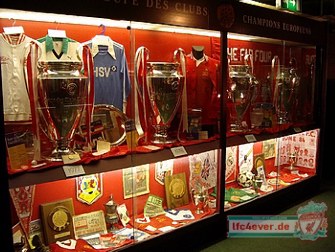 |
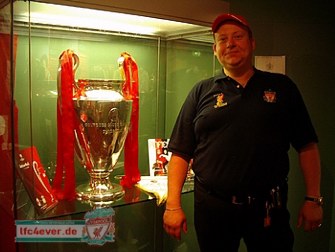 |
Owen ging zu Real, Danny Murphy & einige andere zu Clubs in der Premier League oder nach Schottland!
Nach langem Tauziehen konnte Steven Gerrard in Anfield gehalten werden und spielte zusammen mit Carra der die Saison seines Lebens spielte, eine Tragente Rolle zu einer Bemerkenswerten Champions-League Saison!
Was in der Premier-League überhaupt nicht klappte schaffte man im Nachfolgewettbewerb des Landesmeister-Cups!
In der Liga abgeschlagen nur auf Platz fünf gelandet schaffte Pool im 50.Finale des EC1 die Sensation gegen den AC Milan als erstes Team ein 0-3 zur Halbzeit in einen Sieg umzubiegen! Mit den Phantastischen Fans im Rücken startete Pool eine Aufholjagd die es noch nicht gab, und drehte das Spiel in der zweiten Halbzeit noch zu einem 3-3!
Nach der Verlängerung gab es dann die Entscheidung vom Punkt, in der Dudek zum Helden des Abends wurde!
In der 119. min der Verlängerung hatte er noch zwei "unhaltbare" von Schewtschenko gemeistert und brach nun auch das Herz von Milan!
Erst pariert er den Elfmeter gegen Pirlo & dann hält er mit einen Superreflex noch gegen Schewtschenko & macht denn Titelgewinn damit perfekt!
Die Eröffnung der neuen Champions-League Saison mit dem Supercup in Monaco konnte Pool nach einem 0:1 Rückstand gegen CSKA Moscow noch drehen und mit 3:1 (1:1;0:1) n.V. gewinnen!
2005-06 wollte man nun denn Angriff auf die Meisterschaft wagen, aber die Truppe von Benitez schaffte in der Saison 2004/05 nur den fünften und ein Jahr später den dritten Platz in der Premier League.
Ende Januar wurde für viele Reds ein Traum wahr, God wurde von Man City für den Rest der Saison nach Anfield zurück geholt und bekam dann wirklich einen neuen Jahresvertrag!
Im Mai gewann Benítez mit Liverpool den FA-Cup. Bei einem 0:2-Rückstand schaffte Liverpool gegen West Ham United FC noch den 3:3-Ausgleich und setzte sich gegen den Londoner Verein schließlich im Elfmeterschießen mit 6:5 durch.
2006-07 Liverpool kann durch ein 2:1 gegen Chelsea zum 15. Mal das Charity Shield gewinnen!
Dafür wurde wieder der Start in der Liga verschlafen, und am Ende reichte es erneut nur zu Platz 3.
Dafür schafften die Reds denn Sprung in das Finale der Champions-League, wo wir mit 1:2 die Neuauflage des 2005`er Finals gegen den AC Milan verloren, nach dem wir wieder Chelsea im Halbfinale Schlagen konnten!
Am Ende der Saison verlässt uns Robbie "God" Fowler in Richtung Cardiff City, nach dem er keinen neuen Vertrag bekommen hatte! :(
2007-08, Liverpool kauft von Athletico Madrid denn Stürmer Fernando "El Nino" Torres` für ca. 38 Millionen €!
El Nino schlägt auch gleich toll bei denn Reds ein, und erzielt in seiner ersten Saison 24 Tore!
Im November können wir in der Champions-League Vorrunde Besiktas mit 8:0 Schlagen und damit den Höchsten Sieg in der CL-Geschichte feiern!
Nach guten Leistungen müssen wir uns erst im Halbfinale Chelsea geschlagen geben!
In der Liga reicht es wiederum nur zu einem 4.Platz, und im FA-Cup scheitern wir in der fünften Runde an Barnsley.
2008-09, diese Saison soll (muss) es eigentlich mit der 19. Meisterschaft klappen, aber nun ja, durch Verletzungen unserer Leistungsträger Stevie G & El Nino reichte es nach starker Hinrunde und ohne Heimniederlage in dieser Saison nur zu dem zweiten Platz mit vier Punkten hinter ManU, die damit mit uns in den Meisterschaften aufschlossen!
Besser lief es in der CL, wo wir immerhin Real Madrid mit 1:0 (in Madrid) und 4:0 im Achtelfinale Schlagen konnten!
Dieses mal scheitern wir im Viertelfinale an Chelsea durch eine undiskutable Heimpleite (1:3) die wir auch nach gutem Spiel in London (4:4) nicht mehr abfangen konnten!
Stevie G erzielt am 1.Okt.2008 v PSV Eindhoven sein 100 Tor für die Reds und gewinnt den FWA Player of the Year: 2009 &
PFA Player of the Year (Fanwahl): 2009
Am Ende der Saison verlieren wir Alonso an Real Madrid, viel Erfolg für Ihn und danke für seine Leistungen bei uns!
2009-10, Nach der tollen Saison 08-09 hatten wir uns nun etwas mehr zugetraut, aber der Weggang von Alonso konnte leider nicht kompensiert werden, da vor allem Aquilani, der Alonso hätte ersetzten sollen, durch Krankheiten und Verletzungen nie ins Spiel fand!
Dazu kam noch das festhalten von Rafa an Lukas, so wie das wir kein Geld für Zukäufe in der Kasse hatten!
Einzig Glen Johnson konnte von den neuen überzeugen!
In der CL kamen wir nicht über die Gruppen Phase hinaus und wurden dritter, so das wir wenigstens noch uns für den UEFA-Cup (neu Europa-Liga) qualifizieren konnten!
Hier reichte es bis ins Halbfinale, wo wir an Atletico Madrid scheiterten.
Da wir uns im League- & FA-Cup schon zeitig an vermeintlich kleinen aufrieben und sogar an Reading im FA-Cup zuhause scheiterten wurde diese Saison nur noch von unserer Platzierung übertroffen, Platz 7 reichte für die Qualli zur Europa-Liga, aber nur weil Pompey sich nicht gemeldet hatte!
Ende Mai 2010 wurde dann Rafa entlassen, und Ende Juni nun Roy Hodgson als Manager geholt!
Ob Stevie G & El Nino uns weiterhin erhalten bleiben wird wohl vor allem an der Perspektive liegen die wir ihnen bieten können, Dirk Kuyt will auf jeden Fall bleiben.
2010-11, Ein Thorboelendes Jahr für uns Reds, Roy Hodgson wird nach einer Katastrophalen Hinspielserie im Januar durch Kenny Dalglish ersetzt, der uns wieder in die Spur bringt!
Nach dem wir teilweise nur noch vier Punkte zu den Abstiegsplätzen hatten unter RH, haben wir am Ende der Saison noch einen Akzeptablen fünften Platz erreicht.
Unsere Winterneuzugänge Andy Carroll von Newcastle, der teuerste Vereinseinkauf ( £35 Million), und Luis Suarez von Ajax haben sich gut eingefügt (vor allem Luis)!
Der Verkauf von F. Torres für 60 € Million (Vereinsrekord) an Chelsea war auch keine Schwächung, im gegenteil!
Kenny bringt junges Blut in die Mannschaft mit John Flanagan, Jack Robinson, Jonjo Shelvey und Jay Spearing, wenn auch nicht ganz freiwillig, fielen doch mit unserem Captain Stevie G und Daniel Agger zwei Säulen des Teams bis Saison ende verletzungsbedingt aus!
Raul Meireles bekommt denn PFA Player of the Year (Fanwahl): 2011.
Nach einigen hin und her bleibt Pepe Reina doch bei uns, Dirk Kuyt verlängert frühzeitig seinen Vertrag bis 2013.
Im Mai bekommt King Kenny von Pool einen drei Jahresvertrag, und wir können in eine bessere Zukunft schauen.
Ach ja, und die German-Reds-Leipzig (AIB) feiern am 16.05.2011 ihr 10. Jähriges Bestehen!
When Liverpool FC participated in the 2001 UEFA Cup final with a memorable win in Dortmund after a 5-4 golden goal against Deportivo Alaves, the Spanish team, it all then happened! Three German fans of the English record-breaking champions decided to establish a German fan club. Uwe Kaiser, Benjamin Gordon and Thomas Kunze named their fan club The German Reds. But Liverpool FC has many followers in Germany. This great team from ‘the island’ with its passion, its indomitable will to win and its player legends as in Kevin Keegan, Kenny Dalglish and Steven Gerrard exudes something uniquely special.
An example of this was the Champions League final in 2005 when Liverpool at half time looked to be facing a seemingly hopeless 0-3 defeat against AC Milan then came back to triumph a fantastic win. And who doesn’t know "You'll never walk alone" that originated in the heart of Liverpool and has spread to all the four corners of the world, reaching avid fans everywhere. This enthusiasm, this always believe in yourself attitude, and the success of the team with its fans have together founded the myth of Anfield Road. They are the reason why the German Reds have grown from the original three founder members to a membership of almost 250, who come from all over Germany, Austria, Switzerland and England. Thus the ‘friendship between fans’ can unite the world! In order to build on this, a joint central meeting is held alternately in Germany and in Liverpool. Otherwise everyone plans their own travel to Anfield Road or individually or in small groups with the LFC in Europe, while the fan club takes care of coveted tickets and at the same time as an official Branch also works towards building a closer cooperation with Liverpool FC. Since then the German Reds - Leipzig has become better known as
The German Reds - Germany.
2011-12, Die neue Saison begann hoffnungsvoll, nach einem 1:1 zuhause gegen Sunderland können wir mit 0:2 bei Arsenal gewinnen!
Aber schon im September bekommen wir bei denn Spurs mit einem 0:4 denn ersten Dämpfer, der sich dann wie ein roter Faden durch die Saison ziehen wird!!!
King Kenny setzt scheinpaar alles auf die Cup's, wo wir souverän von Runde zu Runde kommen und bis in die Halbfinale kaum Probleme bekommen, trotz Stoke, ManU und Brighton, die wir seltsamer Weiße jeweils in beiden Cup's Spielen! In der Liga sind wir diese Saison vor allem in Anfield sehr anfällig, wo sonnst die Gegner kommen um die Punkte bei uns zu lassen, verlieren wir vor allem gegen die vermeintlich "kleinen" wichtige Zähler!
So Verlieren wir erstmals überhaupt gegen QPR & Fulham in Anfield, und auch West Brom nimmt die drei Punkte dankend mit! :(
Auch stellen wir mit über 30 mal Holz (Pfosten/ Latte) wohl einen einsamen Rekord für eine Saison (im mittel maß) auf!
Als Plus bleiben die drei Siege gegen Everton mit einem Hattrick von Stevie G in Anfield (2:1 im FA-Cup-semifinal) und Chelsea (2:0 im League-Cup), das Semi gegen Man City im League-Cup, das wir Dank Stevie G seinen zwei Pen & Bellamy gewannen so wie der Sieg im League-Cup (5:4 nach Elfmeterschießen gegen Cardiff City) und das erreichen des FA-Cup-Final!
Leider können von unseren neuen Spielern nur Craig Bellamy & Downing überzeugen, vor allem Henderson und Andy Carroll kommen nicht in die Startlöcher und sind teilweiße Totallausfälle!
In der zweiten Mai Woche wird Kenny Dalglish entlassen, eine Maßnahme die wohl die wenigsten mittragen können, geschweige denn verstehen, aber „Geld verdirbt den Charakter" , nun auch bei uns! :(
Ein neuer Manager ist noch nicht gefunden und wer auch immer es wird, er hat schwere Aufgaben vor sich!
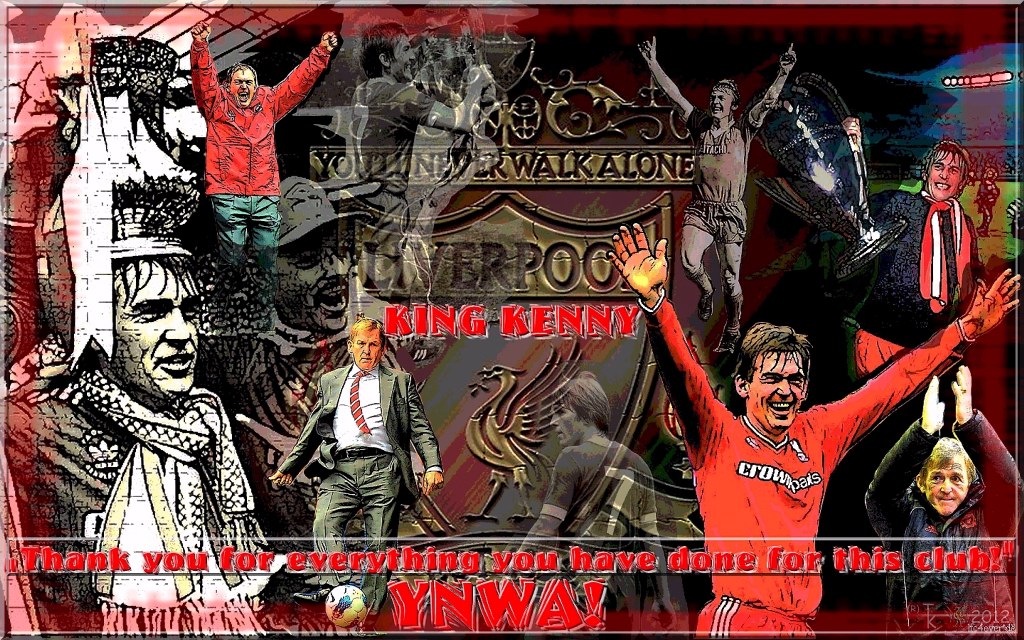 |
2012-13 Wir haben mit Brendan Rodgers (der einen drei Jahresvertrag bekommen hat) einen neuen Manager gefunden der trotz seiner noch jungen Jahre mit Swansea City einen nicht unerheblichen Erfolg vorzuweisen hat.
Er führte The Swans in die Premier League und konnte mit Ihnen die Liga halten!
Der am 26. Januar 1973 in Carnlough (Nordirland) geborene Manager mußte seine Spielerkariere verletzungsbedingt bereits im Alter von 20 Jahren frühzeitig beenden. Als Jugendtrainer begann er dann beim Reading FC von wo er 2004 in gleicher Funktion zum Chelsea FC wechselte.
Seinen ersten Job als Cheftrainer war am 24. November 2008 beim Watford FC mit dem er noch denn Klassenerhalt in der Football League Championship (2.englisch Liga) schaffte!
Im Juni 2009 unterschrieb er einen drei Jahres vertrag beim Reading FC, wo aber nach einem Fehlstart seine Tätigkeit bereits am 17. Dezember 2009 endete!
Am 16. Juli 2010 nahm er das Angebot vom Swansea City FC die er in der Championship 2010/11 auf Rang drei führte und damit in die Play-Off-Runde, wo er gegen Nottingham Forest nach einem 0:0 & 3:1 ins Finale einzog.
Hier traf er auf seinen alten Club Reading, gegen die Swansea mit 4:2 gewann und in die Premier-League aufstieg!
Nach einer doch durchwachsenen Saison mit dem frühen aus in denn Cups & einem enttäuschenden 7. Platz in der Liga sind wir 2013/14 nicht international verträten!
Einziger Lichtblick ist unser Neuzugang Daniel Sturridge der in der Winterpause am 2. Januar 2013 von Chelsea zu uns kam.
Er trifft gleich in seinem ersten Spiel für uns im FA-Cup v Mansfield Town.
2013-14 Diese Saison war das Ziel ein Platz in Europa!
Wir gewinnen die ersten drei Spiel mit 1:0 und bekommen denn Dämpfer heim v Southampton (1:3).
Danach Spielen wir eine Starke Saison (bis auf die Cups, wo leider bei Zeiten Schluß ist) in der Premier-League, wo wir u.a. mit einem 5:0 an der White Hart Lane (im Rückspiel 4:0), 5:1 v Arsenal in Anfield und dem double v Manure (1:0, 3:0) überzeugen können.
Es jährte sich Hillsborough zum 25. mal, 96 never forgotten, und wir empfangen Man City zum spiel um die Meisterschaft. in einem Engen und Klasse Matsch können wir mit 3:2 gewinnen. Besonders beindruckend war die Choreografie vom Kop und das verhalten der Citiziens, einfach Gänsehaut pur!
Einen sehr gute Entwicklung haben bei uns Hendo, Sterling, Coutinho und Flano genommen, die nicht aus der Mannschaft zu verdrängen sind.
Dafür hatten wir mit Enrique leider einen Langzeit verletzten der doch mit seinen Vorstößen uns fehlte.
Stevie G hat nun auf seiner 6. Position sich gut eingefügt und kann das Spiel von hinten führen!
Luis Suarez ist endlich in der League angekommen, mehr als 30 Tore Geschoßen, und hat die beste Saison bei uns gespielt, wofür er den LFC 2014 Players' Awards, Footballer of the Year by the Football Writers' Association & PFA Player of the Year erhalten hat.
Nur unsere Abwehr ist eine große Baustelle, mehr als 50 Gegentore sagt leider einiges, trotz Agger, Skrtel und Toure.
Hier muß was in der neuen Saison passieren.
Das Ziel Europa haben wir mit dem erreichen der Champions-League mehr als erreicht ...
Brendon Rodgers erhält einen vier Jahresvertrag und Stevie g verlängert bis 2016, Scouser Herz was willst Du mehr!?!
2014-15 ...
(c.) Thomas Kunze
Einige Fakten in Kürze ...
Beim Gewinn der Meisterschaft 1966 wurden nur 14 Spieler über die Saison eingesetzt.
Am 5. September 1896 verlor Liverpool 1:0 gegen die Blackburn Rovers während des Spiels wurden jedoch sechs Tore nicht anerkannt.
Das erste Spiel innerhalb eines Wettbewerbs war für Liverpool das Spiel gegen Higher Walton in der Lancashire League. Wir gewannen 8:0 und hatten dabei keinen englischen Spieler in der Aufstellung.
Liga-Debut: 2. September 1893 2:0 gegen Middlesbrough F.C. (Division 2)
FA Cup Debut: September 1893 3:0 gegen GRIMSBY TOWN
Höchster Sieg: 11:0 gegen Stromsgodset Drammen am 17. September 1974 im EUROPEAN CUP WINNERS CUP
Höchster Sieg in einem Ligaspiel: 9:0 gegen Chrystal Palace 1990/ 1. Division (old)
Höchste Niederlage: 0:8 gegen Huddersfield Town 1935
Erster Erfolg: Gewinn der Second Division 1894
Erstes europäisches Spiel: 17. August 1964 5:0 gegen KR Reykjavik Island innerhalb des Europapokals (UEFA-Cup)
Ian Rush hat innerhalb einer Saison in allen Wettbewerben die meisten Tore für Liverpool geschossen: 49 in der Saison 1983 / 84
Roger Hunt hat die meisten Tore innerhalb einer Saison innerhalb der Liga geschossen: 41 in der Saison 1961| 62
Vier Spieler haben fünf Tore innerhalb eines Spiels erzielt:
Andy McGuigan 1901 / 1902
John Evans 1954 / 1955
Ian Rush 1983 / 84
Robbie "God" Fowler 1993 / 94
Das Lied "You'll Never Walk Alone" ursprünglich von Rodgers and Hammerstein und bekannt in der Version von Gerry and the Peacemakers
ist die Hymne von Liverpool FC.
Dreamteam des Liverpool FC
Vier Schotten, ein Waliser, ein Mann, der mit Bananen kickt und einer, der mit seinem linken Fuß Orangen schälen kann, bilden das Gerüst unserer Auswahl der besten elf Spieler des Liverpool FC aller Zeiten.
Der Liverpool FC gehört nicht nur zu den beliebtesten und bekanntesten Clubs aus England, sondern ist mit 18 Meistertiteln und fünf Siegen im Europacup der Landesmeister bzw. der Champions League auch einer der erfolgreichsten Vereine weltweit.
Seit der Gründung 1892 haben unzählige herausragende Spieler das legendäre rote Trikot überstreifen und an der Anfield Road auflaufen dürfen. Aus diesem illustren Kreis haben wir nun die elf besten Akteure ausgewählt, um die beste Liverpool-Elf aller Zeiten zu küren. Die Kriterien, nach denen wir unsere Auswahl getroffen haben, sind hart. Gewonnene Titel, geschossene Tore, Ansehen bei den Fans und technische Fähigkeiten sind ebenso ein Kriterium wie die Bedeutung, die die einzelnen Spieler in ihrer jeweiligen Epoche für den Club gehabt haben und wie bekannt ihr Name noch heute in England ist.
Vorwegzuschicken ist, dass die Zeit zwischen 1960 und 1990 die eindeutig erfolgreichste Ära der Clubgeschichte ist und sich die meisten Spieler daher aus diesem Zeitraum rekrutieren. Wir haben allerdings auch darauf geachtet, dass sowohl die weiter zurückliegende Historie des Clubs als auch die jüngere Vergangenheit nicht ganz außen vor bleiben. Trotzdem wird sicherlich der eine oder andere große Name ohne Berücksichtigung bleiben müssen.
Spieler, die es nicht geschafft haben ...
Herausragende Torhüter gab es in der Liverpooler-Clubgeschichte z.B. einige. Und Geschichten gäbe es über sie auch zu erzählen. So ist Elisha Scott (1912-1934) nicht nur der Spieler, der am längsten das Trikot der Reds getragen hat, auch seine Rivalität mit Evertons Dixie Dean ist legendär. Überliefert ist eine Geschichte, nach der sich beide auf der Straße begegnet sein sollen. Deans Kopfnicken beantwortete Scott vor den Augen überraschter Passanten mit einem Hechtsprung, als würde er einen Kopfball des Gegners parieren müssen.
Dann gäbe es da noch Bruce Grobbelaar (1981-1994). Der Mann aus Simbabwe hatte einst in der Rhodesian National Guard gekämpft, hatte als Jugendlicher ein Angebot aus den USA für ein Baseball-Stipendium und war auch sonst für Exzentrik und Extravaganzen bekannt und sah sich seiner Karriere auch mit Manipulationsvorwürfen konfrontiert, wurde zunächst freigesprochen, musste nach einer Berufungsverhandlung Schadenersatz an die Zeitung Sun leisten. Da er die 500.000 Pfund nicht aufbringen konnte, musste er sich bankrott erklären.
Auch auf anderen Positionen hatten wir die Qual der Wahl. Sami Hyypiä hätte man ebenso in der Abwehr aufbieten können wie Mark Lawrenson, Steve Nicol, Emlyn Hughes oder Garry Byrne, der nicht nur hart gegen seine Gegenspieler, sondern auch sich selbst war und trotz gebrochenen Nackenwirbels spielte. Steve Heighway wäre eine der möglichen Alternativen für das Mittelfeld gewesen und auch im Sturm balgten sich viel zuviele Klassespieler um die drei zur Verfügung stehenden Posten.
Gordon Hodgson (1925-36), der mit insgesamt 17 mehr Hattricks fabrizierte als jeder andere Red, Robbie Fowler, der den schnellsten Hattrick der Liverpooler Geschichte erzielte und mit seinem legendären Kokain-Jubel die wohl umstrittensten Torfeier der Fußballgeschichte zelebrierte, und Michael Owen, immerhin Liverpools jüngster Torschütze aller Zeiten, müssen genauso auf der Bank Platz nehmen wie Kevin Keegan... Aber genug der Vorrede, hier ist also unser Dreamteam des Liverpool FC im 4-3-3.
Ray Clemence (1967-1981: 665 Spiele/335 ohne Gegentor)
Wie schon erwähnt, tolle Torhüter gab es in Liverpool immer. Doch Clemence ragt heraus. Zum einen wären da seine insgesamt 335 Partien ohne Gegentor zu erwähnen, aber auch die Tatsache, dass er in elf Jahren als Stammkeeper lediglich sechs Ligapartien verpasste. Clemences Paraden sicherten Liverpool einige Titel - so zum Beispiel im UEFA Cup-Finale 1973, als er im Hinspiel gegen Gladbach einen Heynckes-Elfmeter hielt und Liverpool so am Ende einen Vorsprung von einem Tor gegen die Deutschen hatte.
Herausragend war auch die Saison 1978/79, als der Keeper nur 16 Gegentore in der heimischen Liga zulassen musste. Zu verdanken hatte er das auch seiner für damalige Verhältnisse modernen Spielweise. Clemence klebte nicht auf der Linie bzw. in seinem Torraum, nein, er spielte mit, verließ sein Gehäuse und setzte die gegnerischen Stürmer unter Druck. Gepaart mit seiner Sprungkraft und Reaktionsschnelligkeit machte ihn das zum herausragenden Keeper seiner Zeit und bescherte Liverpool u.a. fünf Meisterschaften, einen FA Cup, zwei UEFA Cups und drei Titel im Europacup der Landesmeister.
Phil Neal (1974-1985: 650 Spiele, 59 Tore)
Er war der erste Spieler, den Bob Paisley 1974 als neuer Trainer von Liverpool verpflichtete und wohl auch einer seiner besten Einkäufe. Der Rechtsverteidiger schlug sofort ein und entwickelte sich zu einem der besten Spieler seiner Generation auf dieser Position weltweit. Mit seinem guten Auge, seinem taktischen Verständnis verhalf er der Defensive zu mehr Sicherheit und sorgte mit seinen schnellen Vorstößen immer wieder für Torgefahr.
Neals Erfolgsbilanz ist einzigartig: Von fünf Europapokalfinals der Landesmeister mit den Reds gewann er vier und erzielte in zwei Endspielen sogar Tore. Zudem holte er acht Meistertitel, viermal den Ligapokal und einen UEFA Cup. Nur die Kapitänsbinde, die ihm in der Saison 1984/85 verliehen wurde, brachte ihm kein Glück. Eine titellose Liverpool-Saison und das Drama von Heysel fallen in diese Zeit, die letztlich auch das Ende von Neal bei den Reds einläutete. Er wechselte in der Folgesaison als Spielertrainer nach Bolton.
Alan Hansen (1977-1991: 620/14)
Der Schotte mit den dänischen Wurzeln hatte als Jugendlicher viele Talente. Er brillierte als Volleyballer, im Squash und auch im Golf und hätte auch in allen diesen Sportarten eine Karriere starten können. Doch zum Glück für Liverpool entschied er sich für Fußball und wurde zwischen 1977 und 1991 als Innenverteidiger zum großen Rückhalt des Teams. "Auf seiner Position ist er der geschickteste, den ich je im britischen Spiel gesehen habe", lobte laut lfchistory.net sein Entdecker Paisley. "Es ist eine Freude ihm zuzusehen."
Hansen war nicht nur kompromisslos im Zweikampf - Härte hatte er schon als 15-Jähriger bewiesen, als er in einem Jugendclub gegen ein Glasschild gelaufen war und sich eine Platzwunde auf der Stirn zugezogen hatte, die mit 27 Stichen genäht werden musste -, er glänzte auch durch Schnelligkeit und die Fähigkeit das Spiel zu eröffnen. Damit hatte er großen Anteil an acht Meisterschaften, drei Europacups, sechs Pokal- und drei Ligacup-Siegen. Hansen hatte aber nicht nur an den großen Erfolgen Anteil, er stand auch bei den zwei größten Tragödien der Fußballgeschichte auf dem Feld - 1985 im Heysel-Stadion und 1989 in Sheffield.
Nach seinem Karriereende machte er sich auch als Kolumnist und TV-Experte einen Namen. Bei der BBC soll Hansen laut Daily Mail für jeden Auftritt in der Sendung Match Of The Day £40.000 bekommen.
Jamie Carragher (1996-?: 671/5)
Mit zehn gewonnenen Trophäen (u.a. zweimal FA Cup und einmal Champions League) und als Spieler mit den zweitmeisten Pflichtspieleinsätzen und den meisten Europapokalspielen der Clubgeschichte, ist auch Jamie Carragher aus unserer Topelf nicht wegzudenken. Dabei war er als Kind glühender Anhänger des verhassten Lokalrivalen. Es waberte sogar lange Jahre das Gerücht durch Liverpool, Carragher habe ein Everton-Tattoo auf dem rechten Arm und würde deshalb vornehmlich langärmlige Shirts tragen.
Das stimmte natürlich nicht, Carragher liebt mittlerweile nur noch den Liverpool FC - und zwar heiß und innig. Der Erfolg mit den Reds steht für ihn über allem - sogar über Siegen mit der Nationalmannschaft. Über den verschossenen Elfmeter im WM-Viertelfinale 2006 gegen Portugal schrieb er in seiner Autobiografie: "Ich verfehle lieber für England als für Liverpool." Aussagen wie diese, seine große Einsatzfreude, aber auch seine leidenschaftliche, manchmal allerdings auch überharte, Spielweise machten ihn zum absoluten Fanliebling.
Alec Lindsay (1969-1977: 248/18)
Zunächst hatte die Verpflichtung Lindsays nach einem großen Missverständnis ausgesehen. Trotz seiner vielseitigen Verwendbarkeit - er wurde als Mittelfeldspieler eingekauft, spielte im Reserveteam aber im Stum - tat sich der Junge schwer, einen Platz im Team zu finden und wollte Liverpool bereits entnervt wieder verlassen, als ein Ersatz auf der linken Abwehrseite gesucht wurde. Und genau dort schlug Lindsay ein.
Er war zwar nicht der Schnellste, doch diesen Makel machte er mit großartigem Stellungsspiel und einer schon fast an Prophetie grenzenden Fähigkeit zu antizipieren wett. Herausragend war jedoch sein linker Fuß, mit dem er "eine Orange hätte schälen können", wie Entdecker Bill Shankly laut independent.co.uk einst schwärmte und der ihm großen Anteil an Meisterschaft und UEFA Cup-Sieg 1973 und dem Triumph im FA Cup ein Jahr später bescherte.
Billy Liddell (1939-1961: 534/228)
Der gebürtige Schotte Liddell hatte zwar bereits 1938 auf Empfehlung von Matt Busby als Amateur unterschrieben, steig ein Jahr später für ein wöchentliches Salär von drei Pfund zum Profi auf, konnte sein offizielles Liverpool-Pflichtspieldebüt wegen des ausbrechenden Zweiten Weltkriegs erst 1946 bestreiten. Doch in Freundschaftsspielen hatte der Rechtsaußen in der Zwischenzeit schon sein großes Talent unter Beweis stellen können und schlug auch in der Liga mit einem Doppelpack gegen Chelsea voll ein und half den Meistertitel 1946/47 zu sichern.
Neben seinem strammen Schuss, seinen technischen Fähigkeiten und seiner Power zeichneten das Kraftpaket Liddell aber auch seine Fairness und vor allem seine Liebe zum Club aus. Denn obwohl es mit dem Club zu Beginn der 50er Jahre sportlich bergab ging, hielt der gläubige Christ, der niemals trank oder rauchte, Kop die Treue und sorgte mit seinen Toren dafür, dass die Reds nicht in der sportlichen Bedeutungslosigkeit versanken. Die Fans dankte es ihm, verpassten dem Club ihm zu Ehren sogar den Spitznamen "Liddellpool".
Graeme Souness (1978-1984: 358/56)
Der Schotte war der Spielgestalter der Reds vom Ende der Siebziger bis Mitte der Achtziger Jahre. Souness wurde zu seiner aktiven Zeit als "Bär von einem Spieler mit der Feinfühligkeit eines Violinisten"beschrieben. Doch der Start nach seinem Wechsel aus Middelsbrough war nicht ideal. Souness, dem seine Vorliebe für das Nachtleben bereits zuvor fast die Karriere ruiniert hätte, drohte unter die Räder zu kommen. "Man gab mir den Spitznamen Champagner Charlie", erinnerte er sich später laut lfchistory.net.
Doch er bekam die Kurve. Sein erstes Tor für Liverpool wurde zum Tor des Jahres gewählt und mit seinem genialen Pass auf Kenny Dalglish im Finale des Europacups ebnete er den Weg zur Titelverteidigung der Reds. Souness war fortan die treibende Kraft im Mittelfeld, stieg später zum Kapitän auf und war Garant für weitere Titel. Fünf Meistertitel, drei Europacups, vier Ligapokale und drei FA Cups gewannen die Reds unter seiner Regie, ehe er zu Sampdoria in die Serie A wechselte. Anfang der Neunziger kehrte Souness noch einmal als Trainer zurück an die Anfield Road und gewann 1992 immerhin noch einmal den FA Cup.
Steven Gerrard (1998-?: 556/140)
Obwohl er seine Karriere noch lange nicht beendet ist, ist Gerrard bereits jetzt eine Legende an der Anfield Road. Der zentrale Mittelfeldspieler ist seit mittlerweile 13 Jahren der große Leistungsträger der Reds und wurde von der Queen sogar zum Ritter geschlagen. Anfangs von einigen Verletzungen noch behindert, schwang er sich in der Saison 2000/01 zu großer Klasse auf und führte Liverpool zu drei Titeln, dem FA Cup, dem Ligapokal und dem denkwürdigen 5:4-Sieg über Alaves im UEFA Cup-Finale.
Unsterblich machte er sich aber mit seiner Weltklasse-Partie im Champions League-Finale 2005, als er die Reds nach einem 0:3-Rückstand gegen Milan noch zum Ausgleich führte und im Elfmeterschießen den Pokal sicherte. Gleichsam wertvoll in Defensive und Offensive, laufstark und vor allem überaus ballsicher und passgenau lauten Gerrards Attribute, die seine Schwächen, eine hohe Verletzungsanfälligkeit und seine zeitweise Unbeherrschtheit auf dem Platz mehr als aufwiegen. Wie hoch sein Ansehen im Club und bei den Fans ist, beweist die Tatsache, dass hinter den Kulissen trotz noch 18 Monaten gültigen Vertrags bereits jetzt an einer Verlängerung für weitere zwei Jahre gearbeitet wird.
John Barnes (1987-1997: 407/108)
Seine fußballerische Klasse brachte Außenstürmer Barnes nicht nur zweimal den persönlichen Titel Fußballer des Jahres in England ein, sondern dem Liverpool FC auch zwei Meistertitel, FA Cup-Triumphe und dreimal den Charity Shield ein. Barnes, dem seine Teamkollegen Mitte der Achtziger in Anlehnung an eine Figur aus Dallas den Spitznamen Digger verpassten, war aber auch aufgrund seines Humors und seiner Entertainerfähigkeiten einer der Publikumslieblinge an der Anfield Road und wurde von den Fans auf Platz fünf der bedeutendsten Liverpool-Spieler aller Zeiten gewählt.
Die gegnerischen Fans schmähten ihn jedoch wegen seiner Hautfarbe und warfen Bananen nach ihm. Unwürdige Aktionen, die Barnes - ganz der Entertainer, der er auf und neben dem Platz war, trotz ihrer Abscheulichkeit mit Humor nahm und auf seine ganz spezielle Art und Weise konterte. Im legendären Derby gegen Everton Ende der 80er beförderte er er eine dieser Bananen per elegantem Hackentrick vom Feld. Am besten charakterisiert ein überlieferter Ausspruch von Sturmlegende Tom Finney das Talent von Barnes: "Spieler wie ihm begegnet man nur einmal im Leben."
Kenny Dalglish (1977-1990: 515/172)
Das trifft auch auf Dalglish zu. Sieben Meisterschaften, drei Europapokalsiege und fünf nationale Pokale als Spieler und Spielertrainer (zwischen 1985 und 1991) machen den Schotten zu einem der erfolgreichsten Spieler aller Zeiten und brachten ihm unter den Liverpool-Fans den Beinamen King Kenny ein. 1977 als Ersatz für Kevin Keegan verpflichtet, konnte er seinen Vorgänger schnell vergessen machen und eroberte sich mit seinem Siegtor im Europacup-Finale 1978 gegen Brüssel einen Platz in den Geschichtsbüchern des Clubs.
Mit jedem weiteren Titel, aber spätestens nach seinem Einsatz für die Hinterbliebenen der Tragödie von Hillsborough stieg Kenny zur Kop-Ikone auf. Mit seiner Frau besuchte er Trauerfeiern, verlas selbstverfasste Trauerreden und versuchte so die Katastrophe zu verarbeiten und den Opfern Respekt zu zollen. 1990 holte er als Trainer letztmalig die Meisterschaft und trat im Februar 1991 zurück. 20 Jahre später startete er das Comeback und arbeitet derzeit daran, die Reds zurück zu alten Erfolgen zu führen.
Ian Rush (1980-87; 88-96: 660/346)
Mit 346 Pflichtspieltreffern ist Rush der unangefochten beste Torjäger der Clubgeschichte und derjenige, der den Ruf des Liverpool FC Anfang und Mitte der Achtziger Jahre maßgeblich mitprägte. Seine Karriere in Liverpool kam zwar nur langsam in Tritt, doch dann explodierte er förmlich. In der Saison 1981/82 schoss er 30 Tore in 49 Pflichtspielen - und in dem Stil ging es weiter.
Seine beste Saison hatte er ohne Zweifel ein Jahr später, als er sich mit 50 Toren in allen Pflichtspielen als erster Brite den Goldenen Schuh holte. Doch Rush war nicht nur ein Vollstrecker, sondern glänzte auch mit läuferischem Einsatz und viel Arbeit für seine Mitspieler. Er bereitete auch Treffer vor, half hinten aus und legte so den Grundstein zu fünf Meistertiteln, drei FA Cups, fünf League Cups und dem Europacup 1984. Unterbrochen wurde seine Zeit in Liverpool nur durch ein einjähriges, aber erfolgloses Gastspiel bei Juventus Turin, wo er sich nicht hatte durchsetzen können. Über das verlorene Jahr witzelte er in der ihm eigenen Art laut nesn.com später: "Das war wie in einem fremden Land zu leben."
Bill Shankly (1959-1974)
Auch wenn Shankly nicht ganz soviele Trophäen hatte sammeln können wie sein Nachfolger Bob Paisley (1974-1983), muss man ihn trotzdem als den besten Manager aller Zeiten der Reds betrachten. Er war es schließlich, der nach seiner Amtsübernahme den nach unten taumelnden Club wieder auf Vordermann brachte und mit dem Aufbau einer vernünftigen Infrastruktur und der Verpflichtung neuer, talentierter Spieler die späteren Erfolge in Europa überhaupt erst möglich machte. Er verpasste Liverpool die neue Philosophie, auf der Paisley später aufbauen und sie weiterentwickeln konnte. Kein Wunder, dass Shankly in Liverpool absoluten Legendenstatus genießt. Dazu trug er auch mit der Art seines Umgangs mit den Fans bei. Er suchte immer den persönlichen Kontakt, beantwortete die Briefe der Anhänger persönlich und individuell.
von Malte Asmus (2011)
Quelle: www.stern.de
Liverpool FC were founded on 15 March 1892 by John Houlding, the owner of the Anfield stadium. Previously the ground had been occupied by Everton FC but after a disagreement over rent the Toffees moved to Goodison Park. Left with a football ground and no players, Houlding formed his own team.
Early success
After starting life in the second division, the Reds gained promotion to the English top flight in the 1893/94 season and took the league title seven years later. Two more titles came back-to-back in 1921 and 1922, but a run of mid-table finishes followed before topping the league once again in 1946/47. However, in 1954 they dropped into the second division.
Shankly starts
The arrival of Bill Shankly as manager in December 1959 transformed the club. He modelled himself on Napoleon and once said: "My idea was to build Liverpool up until eventually everyone would have to submit and give in." Promotion, three first division titles, two FA Cups and a UEFA Cup final victory (against Club Brugge KV in 1976) later and he had achieved that goal.
Trophies galore
Further success came under Shankly's successor, Bob Paisley, who had been first-team coach. Under his guidance Liverpool won six more league titles and three European Champions' Club Cups, the first in 1977 after a 3-1 win against VfL Borussia Mönchengladbach, the second a year later with a 1-0 win over Club Brugge KV and the third, in 1981, following a 1-0 win over Real Madrid CF.
Fagan wins treble
Paisley was followed by Joe Fagan, another member of the famous Anfield "Boot Room". He toasted the end of his first season in 1984 with a treble of the league title, European Champions' Club Cup - won in Rome on penalties against AS Roma - and a fourth consecutive Football League Cup. However, Liverpool's attempt to win a fifth European Cup 12 months later was overshadowed by the tragedy at the Heysel stadium in Brussels when 39 people died before the final against FC Juventus, which the Italians won 1-0.
Dalglish era
English clubs were subsequently banned from Europe but Liverpool's domestic dominance continued under Kenny Dalglish, who took over in 1985. Initially still appearing as a player, Dalglish guided the club to a league and FA Cup double in 1986 and added further titles in 1988 and 1990 before surprisingly resigning the following year. Sadly, the era was also marked by further tragedy when 96 Liverpool fans died after a crush on a terrace during an FA Cup semi-final at the Hillsborough stadium in Sheffield on 15 April 1989.
Fall and rise
In recent years Manchester United FC have eclipsed Liverpool as England's dominant side, but the Anfield club re-emerged again in 2000/01 under French manager Gérard Houllier, winning the League Cup and FA Cup, then completing a unique treble by beating Deportivo Alavés of Spain 5-4 in the UEFA Cup final. 2001/02: Second in English league. Qualified for 2002/03 UEFA Champions League.
LFC: 120 milestone moments ...
And we start our list on June 3, 1892, the day the Board of Trade acknowledged Liverpool Football Club as a formally constituted company.
1. Liverpool Football Club is officially born, with John Houlding its founding chairman (June 1892)
2. The new club play their first competitive match and mark the occasion with an 8-0 rout of Higher Walton in the Lancashire League (September 1892)
3. Liverpool are elected to the Football League Division Two and get off to a winning start with a 2-0 victory away to Middlesbrough Ironopilis (September 1893)
4. Promotion to the top-flight is secured at the first attempt courtesy of a 2-0 Test Match success against Newton Heath (April 1894)
5. The Reds record what remains their highest-ever victory in League football as Rotherham Town are pummelled 10-1 at Anfield (February 1896)
6. The club's first superstar player Alex Raisbeck joins the club for £350 from Stoke City (May 1898)
7. The highly-regarded Tom Watson is recruited from Sunderland as secretary-manager (August 1896)
8. Liverpool are crowned champions of England for the first time (April 1901)
9. The title returns to Anfield as the Reds finish the season four points ahead of nearest challengers Preston (April 1906)
10. Legendary goalkeeper Elisha Scott makes his senior Liverpool debut and keeps a clean sheet in a goalless draw away at Newcastle (January 1913)
11. The Reds reach the FA Cup Final for the first time but lose 1-0 to Burnley at Crystal Palace (April 1914)
12. Liverpool embark on their first foreign tour with a five-game end-of-season trip to Scandinavia (May 1914)
13. The First Division Championship is clinched for a third time following a 2-1 home defeat of Burnley (April 1922)
14. Liverpool complete back-to-back title triumphs (May 1923)
15. The first ever foreign player is signed when South African goalkeeper Arthur Riley arrives from Boksburg FC (August 1925)
16. A roof is put on the Spion Kop, making it one of the most atmospheric terraces in world football (August 1928)
17. Gordon Hodgson registers his club record 17th and final hat-trick in a Liverpool shirt (February 1935)
18. Liverpool beat Everton 6-0 at Anfield in what is still their best-ever derby win (September 1935)
19. Jack Balmer scores what is genuinely regarded as the quickest-ever Liverpool goal when he nets after just ten seconds of the 3-1 derby win at Goodison (February 1938)
20. Billy Liddell scores his first competitive Liverpool goal as the Reds come out on top in a sensational eleven goal Anfield thriller against Chelsea (September 1946)
21. Albert Stubbins joins the Reds in a record-breaking transfer deal from Newcastle United (September 1946)
22. Jack Balmer creates history by scoring three consecutive hat-tricks (November 1946)
23. Liverpool are confirmed as the inaugural post-war champions after Stoke fail to defeat Sheffield United in their final league game of an extended season (June 1947)
24. Liverpool's first visit to Wembley ends in disappointment as Arsenal run out 2-0 winners to take the FA Cup (April 1950)
25. Anfield's all-time record attendance of 61,905 is set when Wolves visit for a FA Cup fourth round tie (February 1952)
26. Liverpool suffer the indignity of relegation from the top-flight for the third time in their history after finishing bottom of the pile with just 28 points (April 1954)
27. Liverpool endure their heaviest-ever defeat at St Andrews as Birmingham City romp to an emphatic 9-1 success (December 1954)
28. Second Division Liverpool cause the shock of the FA Cup 4th round with a resounding 4-0 victory over their top-flight Mersey neighbours Everton at Goodison Park (January 1955)
29. The floodlights are switched on at Anfield for the first time as the Reds host Everton in a friendly to commemorate the 75th anniversary of the Liverpool County FA (October 1957)
30. Liverpool suffer their most humiliating-ever defeat in the third round of the FA Cup to non-league Worcester City (January 1959)
31. Bill Shankly is appointed as Phil Taylor's successor as manager at Anfield (December 1959)
32. All-time record appearance holder Ian Callaghan makes his Liverpool debut and stars in a 4-1 Anfield win over Bristol Rovers (April 1959)
33. Liverpool smash their transfer record by forking out £37,500 to capture Motherwell forward Ian St John (May 1961)
34. A Kevin Lewis double in a 2-0 home win over Southampton confirms promotion, ending Liverpool's eight-year exile in Division Two (April 1962)
35. You'll Never Walk Alone tops the British music charts and is adopted as the Kop's unofficial anthem (October 1963)
36. Liverpool play in European competition for the first team and mark the occasion with a 5-0 rout of Reykjavik in Iceland (August 1964)
37. Anfield is the setting for the first ever Match of the Day as the Reds host Arsenal on the opening day of the season (August 1964)
38. Liverpool sport their now famous all-red strip for the first time in a European Cup tie at home to Anderlecht (November 1964)
39. The FA Cup is won for the first time as Leeds United are beaten on a historic afternoon at Wembley (May 1965)
40. Liverpool reclaim their mantle as English champions following a 2-1 home win over Chelsea (April 1966)
41. In their first-ever European Final the Reds lose to 2-1 to Borussia Dortmund at Hampden Park (May 1966)
42. Champions Liverpool win the Charity Shield outright for the first time courtesy of a 1-0 win over FA Cup winners Everton at Goodison (August 1966)
43. Kevin Keegan scores in front of the Kop on his debut as Liverpool record an opening day 3-1 success against Nottingham Forest (August 1971)
44. Liverpool win a record-equalling 8th league title (May 1973)
45. Europe is conquered for the first time as Borussia Moenchengladbach are beaten over two legs in the final of the UEFA Cup (May 1973)
46. Liverpool win the FA Cup for a second time following a comprehensive 3-0 thrashing of Newcastle at Wembley (May 1974)
47. Bill Shankly sensationally announces his resignation as Liverpool manager (July 1974)
48. Bob Paisley reluctantly accepts to take over the Anfield managerial reigns (July 1974)
49. Liverpool chalk up their best ever victory with an 11-0 rout of Stromsgodset Drammen in a first round European Cup Winners Cup tie at Anfield (September 1974)
50. A thrilling 3-1 victory over Wolves at Molineux clinches a 9th Championship success (May 1976)
51. FC Bruges are beaten over two legs as the UEFA Cup is won for a second time (May 1976)
52. David Fairclough scores one of Anfield's most celebrated goals as French champions St Etienne are famously defeated in the European Cup quarter-final (March 1977)
53. A goalless draw at home to West Ham is enough to secure a 10th League crown for the Reds (May 1977)
54. Liverpool beat Borussia Moenchengladbach 3-1 in Rome to win the European Cup for the first time (May 1977)
55. Kenny Dalglish joins Liverpool for a British record £440,000 from Celtic (August 1977)
56. Kevin Keegan returns to Anfield with Hamburg but finds himself on the wrong end of Terry McDermott-inspired 6-0 rout that secures the European Super Cup for a first time (December 1977)
57. Liverpool reach the League Cup Final for the first time but, following a goalless draw at Wembley, they are defeated 1-0 by Nottingham Forest in an Old Trafford replay (March 1978)
58. Liverpool become the first English club to retain the European Cup courtesy of a 1-0 victory over FC Bruges at Wembley (May 1978)
59. A 3-0 Anfield victory over Aston Villa confirms Liverpool 11th League title (May 1979)
60. Avi Cohen scores for both teams as Liverpool best Aston Villa 4-1 at Anfield to clinch a 12th First Division title (May 1980)
61. Liverpool bury their League Cup hoodoo with a 2-1 victory over West Ham in a replayed final at Villa Park (April 1981)
62. Howard Gayle becomes the first Liverpool substitute to be substituted but only after running amok in Munich's Olympic Stadium as the Reds eliminate Bayern on away goals in the European Cup semi-final (April 1981)
63. Alan Kennedy is the unlikely goalscoring hero as Liverpool defeat Real Madrid 1-0 in Paris to win a third European Cup (May 1981)
64. Liverpool set a new club transfer record to sign Brighton & Hove Albion defender Mark Lawrenson for £900,000 (August 1981)
65. Liverpool Football Club's modern day founding father Bill Shankly passes away (September 1981)
66. Goals from Ronnie Whelan (2) and Ian Rush see Liverpool come from behind to retain the League Cup with a 3-1 victory over Tottenham at Wembley (March 1982)
67. Liverpool celebrate a 13th title triumph in front of the Kop as Spurs are beaten 3-1 on the final Saturday of the season (May 1982)
68. Bob Paisley becomes the first manager to go up the steps at Wembley and collect a trophy as Liverpool win the League (Milk) Cup for a third successive season courtesy of a 2-1 win after extra-time in the final against Manchester United (March 1983)
69. Bob Paisley bows out as Liverpool manager after leading the Reds to a 14th First Division title (May 1983)
70. Backroom stalwart Joe Fagan succeeds Paisley as manager (June 1983)
71. Liverpool and Everton compete in the first all-Merseyside Wembley final but it takes a solitary Graeme Souness strike in the Maine Road replay to decide the destiny of the Milk Cup (March 1984)
72. A goalless draw against Notts County at Meadow Lane is enough to confirm a 15th League Championship triumph (May 1984)
73. Alan Kennedy's successful penalty conversion clinches a dramatic shoot-out victory over AS Roma in Rome and a fourth European Cup for the club (May 1984)
74. A grief-stricken Joe Fagan steps down as Liverpool boss after the Heysel Stadium disaster, in which 39 fans are killed prior to the European Cup Final defeat by Juventus (May 1985)
75. Liverpool achieve the coveted League and FA Cup double. Player/boss Kenny Dalglish scores the only goal of the game to clinch the title at Stamford Bridge and the following week Everton are beaten in the Cup Final at Wembley (May 1986)
76. Club record goalscorer Ian Rush signs off with a goal v Watford on his last Anfield appearance before joining Juventus (May 1987)
77. John Barnes becomes the first black player to sign for Liverpool when he completes his £900,000 switch from Watford (June 1987)
78. Liverpool break their transfer record to capture the signature of Newcastle United's Peter Beardsley, paying the Geordies £1.9 million (July 1987)
79. After going 29 games unbeaten from the start of the season a 1-0 home win over Tottenham confirms a 17th League Championship triumph (April 1988)
80. John Aldridge becomes the first player to miss a penalty in the FA Cup Final as the Reds are surprisingly defeated 1-0 at Wembley by Wimbledon, quashing dreams of a second double (May 1988)
81. After just one season with Juventus Ian Rush re-signs for the Reds from Juventus (August 1988)
82. 96 Liverpool fans are tragically killed at Hillsborough as a result of crushing on the Leppings Lane terrace at the start of the FA Cup semi-final against Nottingham Forest (April1989)
83. Ian Rush comes off the bench to net twice as Liverpool defeat Everton 3-2 in an emotionally-charged FA Cup Final at Wembley (May 1989)
84. A last-gasp Michael Thomas strike denies Liverpool a second double and secures the title for Arsenal on a dramatic night at Anfield (May 1989)
85. A 2-1 home win against Queens Park Rangers sees Liverpool clinch an 18th League Championship (April 1990)
86. Kenny Dalglish sensationally announces that he's stepping down as Liverpool manager (February 1991)
87. Former skipper Graeme Souness is unveiled as Liverpool manager (April 1991)
88. Michael Thomas and Ian Rush are on the scoresheet as Liverpool beat Sunderland 2-0 at Wembley to win the FA Cup for a 5th time (May 1992)
89. Ian Rush becomes the club's all-time record goalscorer (October 1992)
90. Teenage striking sensation Robbie Fowler nets five times on his Anfield debut in a League Cup tie against Fulham (October 1993)
91. A shock 1-0 home defeat to Bristol City in an FA Cup third round replay is the prelude to Graeme Souness stepping down from his post as Reds boss (January 1994)
92. Boot-room boy Roy Evans replaces Souness as Liverpool manager (January 1994)
93. Fans stand on the Kop for a final time before it's demolished to make way for an all-seater grandstand (April 1994)
94. Robbie Fowler scores the fastest hat-trick in Premier League history as Liverpool defeat Arsenal 3-0 at Anfield (August 1994)
95. A Steve McManaman double inspires Liverpool to victory over Bolton Wanderers in the Coca-Cola Cup Final at Wembley (April 1995)
96. Inspired by a young Michael Owen and Jamie Carragher, Liverpool win the FA Youth Cup for a first time with a two-legged triumph over West Ham (May 1996)
97. Michael Owen makes his senior debut against Wimbledon at Selhurst Park and nets to become the club's youngest ever goalscorer (May 1997)
98. In a ground-breaking move by the club Frenchman Gerard Houllier is appointed joint-manager of the Reds alongside Roy Evans (July 1998)
99. Liverpool celebrate their first appearance at Cardiff's Millennium Stadium by defeating Birmingham City on penalties to win the Worthington Cup (February 2001)
100. Michael Owen snatches the FA Cup from Arsenal's grasp with a late brace of goals as Liverpool come from behind to win 2-1 at the Millennium Stadium in Cardiff (May 2001)
101. On a thrilling night in Dortmund Liverpool complete an unprecedented cup treble with a thrilling 5-4 victory over Alaves in the greatest UEFA Cup Final of all-time (May 2001)
102. Michael Owen becomes the first Liverpool player to win the coveted Ballon D'Or (European Footballer of the Year) (December 2001)
103. Goals from Steven Gerrard and Michael Owen seal a 2-0 Worthington Cup Final success over Manchester United in Cardiff (March 2003)
104. Rafael Benitez is unveiled as the new Reds boss (June 2004)
105. Liverpool stage the most heroic ever comeback to win the Champions League on penalties after trailing AC Milan 3-0 at the interval in Istanbul (May 2005)
106. In one of the most exciting FA Cup Finals of all-time Liverpool fight-back to 3-3 against West Ham before taking the cup on penalties (May 2006)
107. George Gillett and Tom Hicks take control of the club (March 2007)
108. Liverpool compete in their seventh European Cup Final but a brace of goals from Pipo Inzaghi condemns them to a 2-1 defeat in Athens (May 2007)
109. Club record signing Fernando Torres marks his Anfield debut with a goal of sublime class in a 1-1 draw with Chelsea (August 2007)
110. Jack Robinson, at 16 years and 250 days old, becomes Liverpool's youngster-ever player when coming on as a second-half substitute in the final Premier League game of the season away to Hull City (May 2010)
111. The managerial reign of Rafa Benitez comes to an end by mutual consent (June 2010)
112. Fulham boss Roy Hodgson is unveiled as Liverpool's 18th manager (July 2010)
113. Following a dramatic courtroom battle New England Sports Ventures (NESV) end months of uncertainty by completing their purchase of the club (October 2011)
114. Roy Hodgson's brief spell at the Anfield helm is brought to an end in the wake of a morale-shattering defeat away to Blackburn Rovers (January 2011)
115. Kenny Dalglish returns for his second stint as Liverpool manager (January 2011)
116. A dramatic transfer deadline day sees two club records smashed as Fernando Torres leaves for Chelsea and Andy Carroll signs from Newcastle (January 2011)
117. Luis Suarez comes off the bench to score on his Liverpool debut at home to Stoke City (February 2011)
118. On their first visit to the new Wembley Liverpool defeat Cardiff City on penalties to win the Carling Cup, the club's eighth triumph in the competition (February 2012)
119. Steven Gerrard becomes the first Liverpool player since Ian Rush to score a hat-trick in the Merseyside derby (March 2012)
120. After the club parts company with Kenny Dalglish in May, Brendan Rodgers is appointed Liverpool manager (June 2012)
Quelle: liverpoolfc.tv
The Life and teams of LFC
« on: April 26, 2013, 11:02:25 PM »
by way of apology this didn't start out to be this long - I was just intrigued by the idea of Liverpool teams reflecting the society in which they grew up and it just grew from there really and much of what I intended has been lost in the surrounding verbiage - if I get the time I'll do some pruning, well a lot of pruning, well maybe re-write the lot and say what I actually intended
anyhoo its here now
if you have the patience to read it then I have no medals to bestow but you'd deserve one
The early years i.e. before my time
When Liverpool FC was born it arrived into one of the worlds greatest cities. Liverpool was a thriving, cosmopolitan whirlpool of different cultures and people. The city thankfully remains unique. The oldest Chinese community in Europe, the only ethnic communities in the UK that refer to themselves by city first rather than skin colour, a city that the Irish consider their European capital. The waterfront is rightly designated a world heritage site, it dominated the lives of millions for centuries. Yet Liverpool FC had to be reinvented by Bill Shankly in the late 50’s the post war years of austerity were tough. He made everybody remember and believe in the Football Club and by association the City. His legacy endures even now not least because it is a story the people want to believe in.
The Rise of Shankly’s Army
For me football and my club began in the 60’s. It began with a small charismatic Scotsman who had the heart of a giant and who breathed life and passion into a struggling football club and helped energise an entire city. He arrived at an incredible time, the austerity of the post war years was ending, the baby boomers were being born and the world belonged to the young. Anything and everything was possible and Liverpool seemed to be at the centre of it all.
The sixties in Liverpool, what a decade that was! The Beatles, the docks, the football, a city as vibrant as any in the world and into this strode the football genius that was Shankly “I was made for Liverpool and Liverpool for me” he proclaimed and how right he was. The right man, at the right time. He embodied so much of what made Liverpool, Liverpool.
Shanks was a staunch socialist who expected and demanded his teams play as he expected them to live. Where everybody contributed what they could for the benefit of all. A simple game of giving and taking passes, of working hard for each other, pass and move. This is the template that he lay down for generations to follow. This was a reflection not just of his up bringing but of the society he was in, a strong working class city with none of the presumptions, nor airs and graces of elsewhere, no false humility either. A City that believed in itself and believed it had a right to express itself. A city that produced 4 young lads that went on to conquer the world. Timing was key of course, it always is.
Shankly built a team of strong minded, physically tough players. Players that used the ball well but had a direct style and functional feel. It was a good team, competitive, capable of beating the best. There was no great tactical play, it largely mirrored the norm of British football. Constructed with some dominant Scottish personalities and hard scouse lads: Yates, Smith, Lawler, Byrne, St John, Callaghan, and scattered with a touch of brilliance from Liddell or Hunt or Thommo. It was not until the first European adventures that Liverpool began to change into a more sophisticated unit. The Liverpool game plan began to emerge, ball retention became key and the tactical element of the game grew in importance, all the while though loyalty, team spirit, that inner belief in what could be achieved when all fighting for the same cause held the whole thing togther.
The growth and success of Liverpool was not merely luck though. The man introduced new training routines and a revolutionary approach to diet. The small sided games and the constant work with the ball were ahead of their time in the UK. His motivational abilities, his ability to communicate with his people were second to none. His introduction of ball playing centre backs and his ability to introduce young talent set a model for others to follow. The Liverpool Way evolved. It was Shanks way primarily, decent and honest but with afierce will to be the very best. If Liverpool did not win every trophy then they gave the impression they could.
Shankly also realised that individualism had to be harnessed by the collective whether it was Liddel’s skill or Keegans dynamism, Dalglish’s vision or Barnes’s balance, it would stand Liverpool in good stead through decades.It was accomplished time and again by those players and managers who placed the team first and personal glory nowhere. It allowed their talents to shape a team that was greater than its parts which in turn made them stars and showcased their abilities, the glory came with the success, it was never, as with other clubs the target.
These were different times, more respectful. The crowds almost entirely male, white and working class, appreciated the work and skill involved, the stadium basic, it was no place for a family day out. It was a release from the daily grind and as such the players were told, a privilege to be allowed to play. The threat of working down pit still loomed large for Shanks, the gap between supporter and player was not so great. The two lifestyles still aligned, the players had privileged lifestyles but they were short lived, normality was one bad tackle away. It was easier for fans and players to have a common bond. The holy trinity, fan, player , manager was possible. Writing cheques could be seen as an irrelevance when any club could create a winning team with very little, when the sport was a meritocracy rather than a plutocracy and the difference hard graft, passion intelligence and talent not money. Money did not dominate as it does now. Respect for managers, policemen, doctors they were all there but the youth revolution of the sixties was going to change all that.
The John Lennon generation, the singing, creative imaginative Kop which was sold to the world, made of ex-conscripts and dockers and factory workers became the 1970’s howling mob of angry dissatisfied unemployed. The promise of a brighter tomorrow became 3 day working week and the uncollected bins of the 70’s, then later the permanent underclass of the 80’s, a country asset stripped of its utilities, the north and south divided, manufacturing destroyed and the prosperous south bouyed by the greed of the City and a European market on its doorstep. Then we saw the results of this restructured Britain of how middle road politics accepted the underclass as unimportant, we saw mediocrity triumph, a drift through two decades of public opinion politics, a middle road that satisfied nobody but kept the grumbling at reasonable levels whilst all the while the ticking time bomb of an aging population, a crumbling infrastructure and an unworkable national debt crept up and up, were the lack of holistic planning saw the health service cracking and education aimed only at the rich.
All that was still ahead, in the sixties the future looked glorious. Liverpool the city was full of ideas and creativity. TV and radio were growing, vinyl and paperback books rocketed off the shelves. Young people had money to spend and things to spend them on. The City was overflowing with confidence. What of Everton you may ask? Well in the 60’s both teams were superb 1 and 2 in the country certainly not because of their owners wealth or TV deals both teams were superb and if Everton suffered it was largely in comparison with its neighbour rather than as a club.
Being Scouse is almost like being part of a separate nation, with a language/dialect of its own, markedly different from those around it, with rising tones and fast delivery. It transcends individual personality and carries a personna of its own but in the 60’s it went beyond Liverpool. Shankly showed an affinity with the city and the people of Liverpool. That a Scottish working class man could adapt and understand the city so well spoke of not only how similar life was in Scotland and the similar way of thinking about so many things, not least England both apart from it and yet tied to it but also how Liverpool could adapt and welcome those with shared beliefs into its bosom. Shanks with his heavy Scottish accent became Scouse by association a grandfather to a youthful generation that needed something to hold on to in turbulent times.
Liverpool and Shanks shared many traits they didn't hide from the truth or confuse it with subtle lies, a spade remains a spade , a bin man, a bin man, a liar, a liar. Yet Liverpool can be contrary, tell them its their idea and they’ll beam and accept it, impose an idea even if its valid and they will fight tooth and nail. It’s a city that likes to think of itself as apart and unique in cotrol of its own destiny.
And the players back then, one of the key features needed was durability, determination to survive. Shanks introduced athletes like Hughes, Keegan, Heighway. Hard, powerful and that’s how we played, no flamboyance. Direct, no spare, constant attacking, recycling the ball, triangular passing, giving the player options, with defenders allowed to follow the ball with others filling in. The Dutch would christen such changes in position total football but it was no fluke how our right back scored remarkable numbers of goals. There were elements of Total Football in how players switched and elements of hard Italian discipline in how we defended and controlled space but we kept poessession, for those watching in black and white Liverpool were the side with the ball.
In the 60’s Liverpool had been de facto Englands 2nd city. It knew its place in the world, it had nothing to prove. Scousers were the chosen people, threats could be laughed away, the sense of humour in the city was legendary and scousers famed for their sharp wit and repartee, Creativity was everywhere, employment too, it felt a far happier place back then.
I can still remember Shankly’s resignation. It was unimaginable, like your grandad telling you he was adopted. Like the Torres transfer only serious. It made no sense. It was the end of an era. The working class game was over, it was time for the next generation to take over. The enfants terrible, the million pound wages and the media saturation, were all largely still ahead. Football was still the peoples game, but it was slipping away. Charlie Nicholas wasn’t George Best but the people themselves they were changing.
The Golden Years
Paisley’s teams were perhaps the most accomplished ever seen in Britain. Capable of taking on and beating Europe and of dominating domestically. They reigned supreme. A continental style of possession combined with typically British aggression and determination. They could control games or fight them out on wet Tuesday November night. By now our success meant we could pick from the very best, we had great squad which meant all we needed to do was tinker round the edges, bring in a couple of players every year to freshen it up no major rebuilding, no sudden changes of style or direction. We were Liverpool.
The brave new world was already creeping in. Video recorders had arrived by 1976 and managers could begin to take a studied look at their opposition. Shirt sponsorship came in during the 78/79 season and we were amongst the first to sell out although plenty of others had joined in even by the end of the season. The implications of this type of deal remained unclear, it felt wrong but its importance was lost.
But what of the people and our support? Hope and expectation were replaced by disillusionment and anger. Seventies hooligan culture grew when youthful exuberance and passion were married with a betrayal of hope and the promise of the sixties became the despair of the seventies. If containerisation saw the death of the docks, the heart blood of the City then ‘Slum clearance’ had ripped its heart out. The tower blocks picked up families like giants in fairy tales threw them down broken and lost. Communities that had taken generations to build, neighbourhoods that had grown together year on year where just ripped apart and cast into planning experiments. A terrible sign of things to come, as modern soulless thinking, clever people doing what they thought was right shredded a city of soul and hope.
From jobs for everyone we went to unemployment, restricted working and poverty. The people tried to do what they always had and stick together. The Unions tried to protect their own. They failed. The social fabric of the country had already broken down. It was everybody for themselves, grab what you can. There was too much anger and resentment, the haves and have nots, the north and the south, a generation that had no war of their own chose its own path to destruction.
Studies have shown repeatedly that discontent and mental illness are not tied direct to poverty but to the difference between rich and poor. The greater the difference between the haves and have not’s, then the greater the degree of mental illness. The greater unfairness in society the greater the unhappiness. That unhappiness and illness incidentally is not simply restricted to the poor.
The Twilight
It could have been any number of incidents or clubs that changed what had become the unacceptable face of English football but it was Heysel that was seen as the turning point. Passion for football became shameful. One of Liverpools proudest boasts, its passionate support was no longer a strength but a problem. The establishment had the ammunition it needed.
By the 80’s society had well and truly changed. Liverpool like many northern towns and cities became a ghetto. Its people ostracised and demonised. It was brought to its knees by a combination of callous and vindictive central government policies together with corrupt and irresponsible local leadership where the strength of socialism, loyalty became a liability and weapon to beat us with. The tories viewed Liverpool in their won words as the ‘toughest nut to crack’ preferring the midlands or the north east to buy their votes. Liverpool for its defiance of the policies so oopposed to its own would be treated as an exemplar and warning to others.
Our supporter base could not hold together, the young and most passionate support became an underclass unable to afford to go to the match and addicted to cheaper more easily accessible drugs they drifted away. In may cases they moved away entirely and the exodus from the City saw nearly half a million leave to find work and lives away. They took with them a great deal of pride, energy and belief.
The understanding and cultural impact of football at this time was still dominated by the match going fan. Channel 4 the station didn’t launch until 1982 meaning the highlights on Match of the Day were many supporters only access to the game. Football Italia did not hit the screens until 1992. Indeed Breakfast TV wasn’t around until 1983 no 24 hour diet of TV back then. Sure the big finals were all live but for the most part football was geared to the match going fan and reported on by newspapers and TV highlight shows. Incidents like a player biting another were hearsay and forgotten within a day unless captured by the one or two cameras at the match.
Heysel though would mark a low point in supporter culture, where the wrong side of passion, the irresponsible and selfish side where brought to account. But also were the complacent stadium owners, the pompous burocrats and archaic infrastructure were identified and questioned. If Heysel made us question the pompous football establishment and the manner of our support Hillsborough ripped any remaining illusions away. It placed football in context. It lent meaning to Shankly’s often misquoted words. Football isn’t about life or death it goes beyond that. It is about communities about a common and shared belief, a unity.
Back to the football and under Dalglish, the team had changed moving away from its most simple style and into a more dynamic and fluid game, arguably playing its most stylish vibrant attacking football. Yet this was the twilight of Liverpool domination, it marked the start of the decline as a traumatised manager failed to appreciate the need to move on players and allowed an aging squad to run out of legs.
Liverpool for three decades had played habit football. The team were so consistent, the turnover of players so gradual. It allowed players to play with familiarity, with instinct. Movement became natural, flowing and second nature. Winning became the norm, not forced but expected. We weren’t complacent and yet we knew we were the best. We knew doing the right things would bring the right result more often than not. It encouraged a team spirit a camaraderie that brought balance, allowed each player to know their worth to the team and the rest of the team to value it. In so doing it largely removed ego’s or at least established an accepted hierarchy for those ego’s to operate in. The club through three decades remained largely a socialist and family institution despite its competitive environment, everybody contributing as best they could. It needed modesty and humility from the star players, excellent man management but they largely all came from a place where that was expected. However a perfect storm of events was brewing.
Midnight
1989 never to be forgotten.
The Aftermath
In 1990 John Smith the chairman of Liverpool resigned a man who had served the club exceptionally well from 1973, a period of unprecedented success. An astute and clever business man he had kept Liverpool ahead of the game financially. David Moores was appointed to take his place, a man whose love of the club was unquestioned but whose business acumen was seriously lacking. Liverpools last title came in the 89-90 season. But by February 1991 Dalglish had had enough and was in desperate need of a break and with an aging side and a crazy 4-4 draw with rivals Everton he resigned mid season expecting (as Shanks had) a short break. Instead the club moved in its own direction but unlike with the appointment of previous managers it moved away from its core values. Souness was the man eventually brought in to replace King Kenny.
A short distance down the East Lancs road a struggling United following 13th and 6th place finishes was launching itself on the stock market in June 1991 in an attempt to generate the additional funds needed to build a winning side.
In 1992 Souness underwent major heart surgery and the sold his story to the worst of the tabloid press.
Television was on the rise. It seems unbelievable now but at the same time as United sold its soul a small unimportant TV company began to see the value in televised sport and was agitating for the creation of an elite football league. The Taylor report and the move to all seater stadiums, the suppression of hooliganism all moved the game into the continental coffee shop domain of the armchair fan and business picked up its ears. Sky was gambling that greed and the British obsession with football could make it multi millions in profit. By February 1992 the Football League had split and the top clubs had voted for the creation of the Premier League. None other than Rick Parry was brought in to broker the deal and be the first supremo of the premier league. Thanks Rick.
The average fan cared little about league structures but by August 92 the first match of the Premier League 1992/93 was beamed into homes across the country. The TV audiences lapped it up. They grew. The audiences abroad were just as appreciative and just as lucrative. The match going fan who thought of their clubs as their own community assets had been usurped in a battle they didn’t even know they were in. The armchair casual fan was now more important than the man going through the turnstile. Football was big business, the working class game had gone forever and now the money game was upon us. Awareness of just what had happened to the peoples game came slowly.
In 1992 following a dire 1990 World cup, the back pass rule and the time rule to stop the keepers retaining the ball were introduced to speed up play and try and cut down on time wasting. This was a tactic many teams used to either frustrate better teams or close out games. As such it meant goalkeepers had to change their game and teams had to either develop better ways to hold the ball or get it back quickly. The rule worked, some teams coped better than others.
The Europeans weren’t far behind in jumping on the money train with the new better improved Champions League introduced for the 1993/94 season. Instigated by the italian clubs desperate for guaranteed income from europe the full impact of this and how it would polarise wealth in the hands of so few were not difficult to forecast. With many clubs agistating for a breakaway european league the authorties compromised themselves whether those countries and clubs on the outside will ever bring enough pressure for an alternative is doubtful.
Did any of these things contribute to Souness’s mismanagement of the club? Probably all of them if we are being honest. Yet Souness’s team were brutal, a pale shadow of what had gone before. He signed players largely in their prime with big reputations but little hunger. The football was uninspiring. David James, Paul Stewart, Mark Walters, Michael Thomas, Mark Wright, Nigel Clough, Neil Ruddock, Julian Dicks, Stig and Dean Saunders a willing player but not in the class of previous no 7’s – desperately bloated reputations – but he did sign one of my favourite players in Rob Jones such a shame that lad’s injuries.
Player power was on the rise, as were United. The club that boasted about being the richest and most popular in the league despite 20 years without a title had just become even richer. David Moores was a poor business man overly conservative and lacking imagination rather than lead we started to stagnate. Although Souness was a Liverpool legend north of the border his playing style was seen as brutal and direct hardly wedded to the Liverpool style and his personality was egocentric, a man who did things his way not the Liverpool way. In his own words he was obnoxious during his time at Rangers. With timid management above him Souness sent about restructuring the reds and got it badly wrong. Wrong man at the worst of times.
The Wilderness Years
Souness gave way to Evans in 1994. The contrast was incredible. It was a typical Moores move. An attempt to be popular and please the fans and roll back the clock to the days of the bootroom. Evans was a good coach and loyal to Liverpool but he lacked the steel to control the young players Liverpool had at the time. The Bosman rule kicked in 1995. Player power and the rise of the agent were with us. 24 hour TV was desparate by now for celebrities to fill the vacuus hours. Footballers became pop stars. This time we probably had the right man just at the wrong time. As a consequence we ended up with the Spice boys. They played great football, they had real talent Fowler, McManaman, McAteer, Redknapp and could certainly have won the league but much like the manager the team had a soft underbelly that let them down. The expansive football meant we conceded way too many goals. The lack of discipline meant our defensive shape could disappear. The form and style improved but the winning mentality alluded us. Our training methods and approach whilst enjoyable were still routed in a different era. We tried to apply 80’s football to a 90’s game. We started to lag behind.
Another little heralded rule came in during 1996 when the bench was raised to 5 substitutes. The top clubs had needed to build up bigger squads to cope with the increased demands of Europe. This meant highly paid assets sitting on the bench twiddling their thumbs. The big clubs again got their way, it was changed again in 2008 to 7 as the squads grew even bigger. With Bosman and bigger squads the way was clear for teams to buy their way to success of course it also help kill the English game producing its own talent. The reserve league structure collapsed and the gap between first team and reserves became massive.
What was happening in Liverpool at that time. The trauma of the 80’s was still remembered. The mass exodus of the on yer bike policies of conservative Britain were over though and New Labour had come to power. Liverpool the City had changed, the power of the trades union movement and local council had been torn away. Socialism was a dirty word but investment in the inner cities and the community were at least back on the agenda. The sixties had been exciting, the nineties were a pause from the pain and grief of the eighties a chance for society to catch its breath. There was hope but the shadow of the eighties still loomed large and the spectre of unemployment remained, along with the underclass, the hopeless.
Rather than address the obvious issue with Evans, Moores always looking to be popular opted for a compromise and brought in a little known French coach with a reputation for discipline. Houllier had won the French title with PSG and had been a key part of the French national set up (France were the leading nation in world football at the time) and was allegedly brought in to help Evans. Their complimentary styles were supposed to produce a winning combination. It was a disaster. Neither was in charge, no roles defined. Evans an honourable man with a deep love of Liverpoolquit at a tear filled press conference it was hard not to despise those who put him in such a position. A good man and a great servant of the club, he did what he thought was right despite the grief it caused him. What more could anybody ask, top top man.
The French Renaisance
In 1998 at first alongside Roy Evans but later on his own Houllier started modernising the club. Its training methods, diet., backroom, staff, scouting. It was an odd appointment, Houllier had limited managerial experience and none in British football. A self professed Liverpool-phile he threw himself into the task of rebuilding. His turnover of players was huge with a slant on an undervalued French speaking market but he was competing with an established set up run buy Arsene Wenger and invariably it was the lesser of the French talent that came to Anfield.
The Kirby academy opened its door in 1998 although Houllier had a limited role in the Academy as Steve Heighway was in charge there he did completely overhaul the old Melwood training ground. However the academies inability to reproduce the talent of the nineties has been an issue for Liverpool both financially and on the pitch and the division between the academy and first team was allowed to grow not least with Houlliers insistence on bringing in young French talent into the first team squad.
Rick Parry arrived at Liverpool in 1998, he came with a reputation as a savvy football administrator who could help transform the club. He became Moores right hand man and his advice over the next decade would shape the club.
Houlliers time in charge consolidated Liverpool’s position as a good European team. The treble of 2001 gave rise to a wave of optimism that Liverpool could fight its way to the top again. A 3rd place finish in the league was followed by the community shield and the super cup however even while Liverpool fans were celebrating Houllier was taken seriously ill and had to undergo a life saving operation. After a 5 month absence he returned to kead the team to finish 2nd. It was widely accepted that Houllier and Liverpool were just a signing short of the big prize. Enter El Hadji Diouf and Bruno Cheyrou and exit Anelka and McAllister. So close and yet so far. Houllier’s management became incredibly defensive, his interiews less convincing and Liverpool’s counter attacking style much less effective, we went backwards.
The emergence of Chelsea had thrown everything at the top end of the league up in the air. A Russian billionaire gangster had arrived to diversify his assets. He wanted a club in London, not least to get away from Russia. He chose the bankrupt Chelsea a club that had been living beyond its means trying to break into the big time. His manager the likeable Claudia Ranieri had spent a small fortune getting them to second place in the league beaten only by the Untouchables side of Arsene Wenger. It wasn’t enough for the Russian Oligarch who’s ego was matched by his ambition.
Liverpool under Houllier had played conservatively probably an overreaction to the expansive style of Evans. They dropped deep and used the mercuarial talent of Owen to launch blistering counter attacks and the supreme ability of Stephen Gerrard to dominate midfield whilst Sami Hyypia emerged as a colossus at the back. It was functional counter attacking football but it became highly predictable and overly defensive as the results dried up. Houllier left the club by mutual consent receiving an incredibly generous and crippling payoff.
Did it reflect Liverpool as a city. A city bought back from the brink of managed decline. It probably did. Liverpool was a gutsy city but remained incredibly defensive about its past. Still capable of moments of brilliance, its culture recovering from the trauma of the eighties and the fact that the City was largely overtaken by the world in the nineties. Liverpool needed a new start. Houllier had provided that.
The Spanish revolution and civil war
During the 2004 season Liverpool had been battered by a Valencia side that played the most impressive football in Europe. The team pressed continually and played possession football in the oppositions half. They’d won an increasingly strong La Liga ahead of both Real Madrid and Barcelona on a limited budget and captured the Uefa cup. Their coach had fallen out with the board over the purchase of a lamp instead of a table. In an amazing coup Liverpool snapped up Rafael Benitez and his long term assistant Pako Ayesteran. Parry and Moores had finaly done something right.2005 saw Liverpool play some of its poorest football in years away. The weaknesses of the squad and some of the current players was mercilessly exposed as they tried to play a style of football that the players could not cope with. Benitez massively underestimated the speed and physicality of the english league. His first encounter with Bolton being a spectacular introduction to a new set of rules. The division with the academy grew as the lack of quality in the youth ranks saw Benitez attempt to buy a whole new reserve team that he could control.
Houllier had tried to instill a French development model, Benitez ripped it up and started again. He was every bit the workaholic that Houllier was, a far better tactician but his PR and media work although calculating were confrontational and the English media took an almost immediate dislike to him. Benitez reflected Liverpool. Things would be on his terms, no false modesty, just loyalty to the club, good honest graft and the respect that comes with it. It unbalanced the whole media equation and besides which they had their own new media darling. Mourinho the special one had arrived fresh from Porto’s domination of Portugal and winning the Champions league. An outspoken egomaniac that loved the camera and pandered to the media.
If two men could be the personifications of their clubs then Mourinho and Benitez were it.
Benitez was able to tap into the community element of the club and create a team that was bigger than its parts. He did it at Valencia and he did it at Liverpool. The 2005 Champions League victory was astounding not just for the final itself a comeback from 3-0 down against the best team playing the best football in Europe but because of the manner in which the team made the final. Beating Chelsea in the semi arguably a team on par with AC Milan and also the Italian champions Juventus in the quarters both teams with better and more experienced players. Getting the results needed in the group despite a depleted squad, utilising players like Biscan, Diao, Traore, Pongolle and Mellor. Turning Carragher into a top class centre half and reminding Milan Baros he was the same forward who played for Czechoslavakia. It was an outstanding achievement. He turned back the clock and showed a City and a club what could be if you believed. He wasn’t Shankly, nobody could be but he shared many of his characteristics and beliefs about the game, loyalty being one of them.
Benitez champions league victory was followed up by another hard fought cup victory in 2006 beating United and Chelsea again en route to another FA win and a much improved league campaign. The man was the real deal not only did he understand football , he understood Liverpool.
Moores with Parry advising him believed he could no longer match the clubs ambitions, Benitez achievements were placing more and more strain on the clubs limited resources. Although TV audiences were still inspired by the great achievements of the past and the marvellous triumph of 2005 as a brand Liverpool needed far more business awareness if it was to compete with the other giants on their terms. Competing with teams far wealthier and with far more resources over a prolonged period of time would have been impossible. Moores had been looking for a way out for years. His own personal fortune was tiny compared to those of his competition. Yet his imagination and that of Parry were poor. Liverpool as a business was amateurish, those in charge failed in their responsibilities to keep the club aligned with modern life. They looked in many of the wrong places, looking out rather than in and for years failed to find the right investment when sponsorship and fresh income were staring them in the face.
In 2007 that all changed a major investment company from Dubai came to the table with a serious offer. A deal was almost struck but at the last minute Moores got nervous. There were some stories leaked in the press about Dubai only being in it for the money. Moores panicked and withdrew. Instead he switched to a separate bid from two American carpet baggers. Whether Dubai would have been right or not I don’t know. I do know that Hicks and Gillet were a disaster.
Initially all seemed well, they said many of the right things and some money was made available to invest in the squad to take it to the next level. A new stadium was promised which would allow the club to compete with the biggest and the best, they talked about modernising the club commercially. On the park Liverpool continued to compete with and beat the best.
Liverpool reached the final of the 2007 Champions league. This time Liverpool were the better team. This time Liverpool lost. Life is a bitch. The final itself was uninspiring but the organisation of the event was terrible. After the game Benitez complained about the new owners for the first time, suggesting that the funds he’d been promised to build further were not there. He did however get to sign a promising young Spaniard Fernando Torres and Liverpool would go on to compete in the semi final of the champions league the following season, a last minute own goal by John Arne Riise would cost them another final.
As Liverpool the city began to recover with unsurprisingly major European investment, it became the European City of Culture 2008. Liverpool One and the arena transformed the city centre. A city largely ignored by successive governments in London had begun to recover it soul. Liverpool however knew what it had always known, Liverpool is not an English city it is a world city.
Rumblings of discontent though surrounded the season in November the American owners threatened Benitez with the sack and to replace him with the untried Jurgen Klinsman. The fans marched to the ground in support of their manager. Porto were hammered 4 -1 with Benitez’s name sung from beginning to end. The owners backed down but trouble was brewing.
That summer saw Liverpool football club falter. The real truth about the selling of the club came out. The two Americans had bought the club on credit and were using the clubs own wealth to fund their purchase. The financial crisis and the rise in interest rates meant their debt was spiralling out of control. Net investment in players went negative. The new stadium could never be built. Despite this or perhaps because of it the Liverpool players produced their best ever premier league season. In 2009 Liverpool lost just two games in the league but still couldn’t get over the line, they finished 2nd despite putting 4 past united, Chelsea, Madrid and Arsenal in the space of a month.
What happened next reflected on both the city and its fans. Whilst the media and sky were happy for Liverpool Football Club to fade away and be bankrupted by its owners just another headline, another famous old club on the rocks the fans came together and formed a protest movement. Those militant buggers would not lie down. They formed the first fan union. A union with members around the globe. It was clear that there are enough fans outside of Liverpool that genuinely get the City to inspire hope in all of us. The pundits told the fans to just concentrate on the pitch, that the business of football had nothing to do with them, it wasn’t their job. This was the media agenda, this what the Sky pundits lined up to tell their mindless masses, just take what we give you and stop complaining. To their shame many Liverpool fans listened. They put their heads down and ignored the plight their club was in. It wasn’t their concern, somebody else would sort it out. Thankfully some fans did not. There were many groups , many unsung heroes who came together to try and avert what looked like an inevitability. That Liverpool would be asset stripped and bankrupted and go the way of Leeds United, Sheffield Wednesday and other names of the past was unacceptable. People began to remember it was their club, that they held the power.
At the end of the 2009 season the Liverpool team striped of investment began to fall apart, players moved on, lost form, lost belief. Benitez struggling as much with the owners as the team was forced to rethink. The team struggled, lacking belief as much as investment. The manager in a show of unprecedented loyalty sided with the fans. By the end of the following season he was sacked. The excuse was that the team had underperformed on the pitch, the off field distractions had clearly effected its spirit and belief and that of the manager. To their shame the majority of fans accepted it citing poor performances and poor transfers and paying no attention to the backroom goings on after all it wasn’t their role to question the business, Sky said so and those things shouldn't effect what happens on the pitch. It was a terrible shame but probably best for both Benitez and the club that they parted ways at that time.
Limbo
Roy Hodgson came in to replace Benitez. A journeyman coach with thirty odd years of football experience. Many thought it a temporary home for somebody looking for the England job. This was a coach who had no rapport with any of his previous clubs, an establishment figure comfortable in the corridors of the FA. The antithesis of a Liverpool manager. Hodgson also had a reputation for dour football, he’d failed at big clubs before and had a reputation for dull uninspiring football. His supporters said that with better players his football would improve. We waited. Whatever the papers say it was not decided before we kicked a ball. We watched. We were appalled; signings, press conferences, style of football, results. He claimed to understand the club and then every word that left his lips showed that he didn’t. He was brought in to manage the decline of a club by owners that believed they could walk away with millions. He was thankfully rejected by the majority. He had an impossible task with the same behind the scenes fiasco to contend with but wheras Binitez tried to fight that battle Hodgson said it was nothing to do with him, he ignored the future of teh club, it wasn't his concern, calling those fans who fought for their club unhelpful and a distratction. The media were up in arms. They championed him, vilified the Liverpool supporters for their lack of patience. The same Liverpool supporters who’s stood by the previous manager for 5 years despite the medias best efforts to unseat him.
Liverpools on field performance went from average to poor with the worst start to a season in living memory.
By October 2010 with the club in turmoil and a bankers flick of the wrist away from administration the protests groups won. The plight of the club had not gone unnoticed. The Royal Bank of Scotland prompted probably as much by the financial implications as the fans stepped in to the failing business to put it right. They found an investor, again from the US ironically enough, prepared to come in and take a chance on what could be a very good deal for the club and a deal was struck. The banks got their money back, the new investors got the club and its assets and the Americans got what they put in, nothing. The fans, well the fans had what was always theirs, hope.
The False Dawn
The new owners FSG were hoping for an easy start to get to know the game but they weren’t allowed the breathing space. Hodgson’s football and results were disasterous and the players disaffected. By January he was gone and FSG had turned to one of the few people that could be trusted to look after the best interests of Liverpool Football club, Kenny Dalglish.Twenty years too late Kenny came back. He transformed the club overnight. It mattered little that his first few results were poor. The fans knew he understood, knew he was one of them. The girders at Anfield thrummed with belief it was alive again. FSG signed a couple of big names and let another one go but Liverpool played football again, they had the highest points total of any team after Dalglish took over that season. The football was crazy, unstructured often relying on the players themselves to sort it out but they played well.
FSG had only intended for Kenny to be interim manager but his performance and his association with the fans made them reconsider. They had an investment policy straight out of baseball. Unfamilair with football they had brought in a clever French man Damien Comolli to oversee the football structure. Comolli and Dalglish tried to find the best young English talent, with hidden value that could lift the team up the table.
The fairy tale would be that Dalglish strode to the league title the following season but he didn’t. Instead the league campaign was a disaster. It was a strange combination of poor tactics, ill luck and circumstances which shredded the team of confidence. The star player was sidelined for 2 months. The expensive signings brought in to revitalise the team stumbled and struggled for form. Instead of coming together it fell apart and although the team reached two cup finals it never inspired any belief in progress.
The Now
FSG still unsure about football reverted to their initial plan and replaced Dalglish with Brendan Rodgers a young coach, inexperienced at the top level but who knew the modern styles of football and had ambitions of his own. He spoke well with the media unlike Dalglish which was a major failing during both of his stints as manager and Rodgers had a clear structure and style of play which lent reassurance to the board.It is too early to pass judgement on the reign of the young Irishman. He seems genuine, a grafter, politically savvy but a little raw round the edges, the big club politics still catch him out, the constant analysis exposes the cracks. He's clever though and the jury is still out on whethre he can manage and inspire respect in amongst the big ego's.
Americans love to specialise and the LFC backroom expanded massively both in support of its playing staff and its business. The number of Liverpool sponsors has grown from one to two dozen in just a few years. The club has been dragging itself from family club to global brand with the target of making money and without asking the basic question of why?
Fifty years ago Shanks said ‘Liverpool exists to win trophies’ sadly that can no longer be the claim. Generating wealth was not the intent of football, few owners took on a football club to improve their finances and any money a club did make was most often ploughed back into the club. It wasn’t altruism but it was as much about community as it was ego and personal pride.
Football ownership has changed. It has moved for local business men to global brand almost in the blink of an eye. The financial advantages some clubs hold would not be tolerated in any other sport. The authorities appear powerless to correct it. They operate at the whim and discretion of those they seek to control. The financial fair play rules are already largely ignored, the accountants who can skip around the tax system can drive a coach and horses through any cowboy rules set up by UEFA or the self imposed guidance created by the premier league.
Today we live in a country were the individual is paramount. It’s the age of celebrity were being famous for anything is more important than achieving something. The community is dying. The old focal points of church and pub are no longer relevant to the TV audience and supermarket shopper. Yet there is a part of people that craves community. Human beans need people, it is a core part of our DNA. We’ve seen it so often of late whether it’s a farcical and over sentimental outpouring of grief for Princess Diana or a glorious Olympic event. The public is desperate to join together whatever the excuse. Football, like religion the previous opiate of the masses is filling a void. Distracting the majority from the banality of everyday life but whereas in the past it was rationed, controlled and had a useful place in society now its saturates everything, dominates the landscape such that the story of a footballer biting an opponent can take precedence over a natural disaster wrecking hundreds of lives.
The last 20 years have been tough for Liverpool. The western world has shrunk in importance. The globalisation of the world has been rapid and is still accelerating. The size of the 3rd world and China are simply staggering. It’s very difficult to keep an identity amidst the confusion. What place does Liverpool the city have in the new world. What place the football club? It was a bastion of socialism and working class values and yet those values are seen by many to be hardly relevant anymore. In a city stripped of much of its meaning and identity how is the football club meant to reflect its community. The modern world thrusts towards homogeneity, sameness, yet individuality is the mantra. It thirsts for familiarity, every high street brand is the same the world over. The franchise approach beckons. We live in a world dominated by money not ideas. Clubs are now businesses and stadiums designed to create wealth not to play football.
The Future
So where to now for Liverpool two decades of football that have seen us struggle to come to grips with who and where we are. Despite the struggles we’ve had plenty of success, success that the vast majority of clubs would swap their own but having been the very best it is not the same everything is compared back to that Golden Age.Liverpool remains a proud and contrary place. It remains unforgiving of its enemies and overwhelmingly forgiving of its friends. It rejects authority in an almost pathological way and prefers to see itself apart, outside the norm. When it is confident it rejoices in its own identity and place in the world which makes it equally loved by its friends and resented by its detractors. Many see its pride as misplaced. They see defiance when they expect acceptance. Those who believe themselves superior expect humility, they receive scorn. In Liverpool when somebody pushes you, you push back harder. This isn’t always the wisest thing to do, pride can have its downside. Yet it is a way of life in a hard upbringing. To balance that pride comes a sharp and biting sense of humour which keeps you on your toes and your eyes sparkling.
Liverpool has always been a place of innovation. The pool of life as dreamed by Carl Jung. Liverpool are in need of that innovation now.
For sure the world will turn. If money is allowed to it will dominate the football horizon in 50 years. It will see the creation of franchises in major cities, it will see the total commercialisationof sport and if it does the game and society will be the poorer for it. It’ll be played in a dozen cities around Europe for the benefit of a privileged elite. It will have lost any relevance to the community and be the sole preserve of big business followed by the empty headed class who chase a need to belong in a society without a soul.
So Liverpool needs to be true to itself whilst at the same time reflecting the reality of where we are and where the game is going. For that we need to look to the City and the population and build from there.
What do we find in modern Liverpool? The city itself is divided not just red and blue but unemployment particularly amongst the young is high. The majority are fed on a diet of 24 hour commercial tv. Insecurity is replaced by bravado, anger is seen as pride and self pity. There are those who in the absence of wisdom and community seek their opinions from soccer am and the daily mail. There are people afraid of being irrelevant, people who want an easy life with no thinking involved and any excuse to party, who’ll accept what they are fed for fear of having to think for themselves. We have a large section of society whose opinions are formed by pundits employed for their looks or celebrity rather than their insight. Then we have the aspiration nation, the lower middle classes, who see football as an entertainment something to be viewed but not heard. This does not feel like fertile ground to rebuild a community club, to find the mass choir of the kop entranced by Shankly’s new signing, celebrating the end of a tough working week, seeking an escape from the harsh realities of the daily grind by supporting their team through thick and thin. We saw even in the grim days of Hicks and Gillet how many traditional supporters preferred to either bury their heads in the sand or deliberately walk the other way rather than acknowledge the truth of how the club was being raped by the boardroom. So many did nothing and yet those who did inspired hope that not all is lost.
The British class system was blown apart in the 60’s but the establishment set about restoring another over the next 50 years. The rich grew richer and the poor poorer. If barriers of race and sex were broken down a new one, wealth, took their place. Just as in the 60’’s 70’s and 80’s any side could be built, emerge from the pack and challenge at the top, over the next thirty years it polarised into only the wealthy having any opportunity to not only succeed but merely compete at the top table. A plutocracy emerged which pandered to the wealthy and fed crumbs to the rest and gave delusive hope to the majority and we to our shame lapped it up and let it happen indeed Liverpool as a club was a real mover in making it a reality.
Modern society is divided between the under classes and the super rich by middle England, the aspiring lower middle class. You can no longer win a General Election on principal it is the middle ground or nothing, tory, liberal, labour they all wear the same face now. Money remains the be all and end all of western society, the arbiter of worth shrouded in a hypocritical cloud of moral righteousness.
There are two conscious choices for football the money model which will lead to a franchised sport or the fan ownership model which will see a community owned game, for the Liverpool of the past there is only one real option and yet we seem wedded to the former and the game itself is stumbling along a free market root guided by a self serving love of money. To be the club I want us to be you have to provide the fans with a vested interest in their club. Something concrete and measurable and something they can control. There is a currently unique opportunity for this. No senior side in England has gone this route, no club has claimed the identity of fan ownership. It would be a massive coup for whoever takes it on. It would make that club accessible and relevant to every genuine football fan in the country and every fan world wide. Liverpool have an opportunity to be the first and to lead the way. To deliver innovation, to change the face of football. What better place than Liverpool to be the birth place of such a movement. It would provide the club the identity it craves, it would both tie it to the past and address the issues around ownership and finances going forward. For two decades we’ve misunderstood our place in football. Ours is not to follow the oligarchs and stockbrokers who see the cost of everything and value of nothing. Ours is to show the rest of the country the way football should be run and football should be played.
One issue right now is whether our current ownership have the vision and imagination to see it and make it happen or would they rather follow as a pale shadow the likes of City and United into an inglorious future of billionaire owners and plastic flag waving fans. The irony that such an opportunity exists for an American owned investment consortium would be delicious except for the pain which occurs if they don’t make the right choices.
As an aside Evertonians , genuine ones not the small minded bitter fools that would rather see Liverpool lose than their own side win, proper Evertonians are good lads, they like their football, they understand it. My brother began life as a red but switched after the heartbreak of Inter Milan. It’s always meant I have a soft spot for the blues. Half my uncles are blue. Half me family really. Eventually, I think both clubs will merge. The worlds a smaller place than it was. Rivalries are no longer across the street they exist across countries. Together as a city, single minded and focussed we can take on anybody in the world divided it’ll be a lot harder and potentially neither of us will be strong enough.
Liverpool believes itself to be anti establishment, innovative and cosmopolitan in its own unique way not filled with intellectuals or pseudo artistic talent demanding to be heard for the sake of it but with an immediate meaningful art, whether sport, music or literature. It still has strong roots in working class views. Year after year Liverpool fans have won awards for being the most fair minded fans in the country. Many of its jobs now may be in service industries or with the government rather than manufacturing, docks, or ship building, the tough manual work is largely gone but the beliefs in equality and justice remain. The people may be the worse for it, less physically hard, soft and squishy but the collective view still remains as shown in election after election.
The cities sense of humour was once legendary, misunderstood by many, resented by others especially those from the London centric south whether its journalists or comedians yet it was grown on the back of hardship and came with a sharp insight and understanding of a hard world.
And physically how do we stack up? Well the majority who make it to the top seem to be able to run all day and are as tough as nails – Smith, Thompson, Lawler, Byrne, Melia, Lee, Callaghan, Fowler , McDermot, Mcateer, Gerrard, McManaman, Carragher, Fairclough, Aldridge, Case. If you add in the catchment areas of Lancashire and North Wales and throw in the likes of Murphy and Rush and Owen. We seem to churn out natural strikers and lean fast marathon men.
The diet we can control the genetics not so much. We don’t have the catchment area -of Barca if we did every player born from Liverpool to Birmingham would be ours. With those of scouse ancestry in the USA and Australia coming home as well. Borrell has stated that Barca specifically looked at the type of player their area created small, balanced, strong and cultured. If that’s true then Liverpool should be looking at a style that suits – tallish, lean, tough players who can run all day and crucially have wits that you can pick a lock with. I remember reading that McMananam finished first in the schools cross country whilst McAteer trailed in a sorry third. I hope we’ve got scouts at the schools cross country every year. Throw in to that mix, loyalty to the point of stupidity, a relentless belief in what is right as shown by the Hillsborough campaign, the fight against Thatcher and the enduring love of the club even in those who leave.
If that’s what we grow in Liverpool then that’s what we should be looking at. A philosophy geared around constant movement and unprecedented pressing not a system invented by Houllier or Benitez or Rodgers or with the greatest respect Borrel but one geared to LFC. A system that relies on a goal scorer with the football intelligence to solve problems in an instant that’s as likely to pick your pocket (defender wise obviously) as bang it in the back of the net.
Conclusions
I’m still trying to figure those out
"In Liverpool gibt es nur 2 Teams:
Liverpool und die Reserve von Liverpool !"
(Bill Shankly)
+++
zurück
